Bread A to Z….
People have been baking and baking bread for over 12,000 years. Probably the first bread was in the form of a cooked paste, which was a mixture of various grains and water. How was this paste created and who came up with it? Was this a deliberate experiment? Or maybe a coincidence? It is not known to this day. The oldest bread that archaeologists have found comes from Crete, and its age is estimated at 6100 years.
At First, the loaves were flat and firm. Nowadays, it would probably be considered unsuitable for eating. Have people ever liked it? I do not know, but it was surely satisfying. Only the Egyptians around 2600 BC figured out how to make the bread plump. It was them, over 4,000 years ago, who baked leavened bread for the first time. There are many stories about the development of leaven. One of them says that a slave girl forgot about the grain mash left in the sun. She was supposed to bake pies for her master. When it turned out that the mash had started to ferment. Not to waste the dough already prepared, she decided to bake pies anyway. And it turned out that they were more plump and tastier than the previous ones. The Ancient Egyptians quickly learned to increase the bulk of loaves by subjecting the dough to spontaneous fermentation, which gave it a springy texture – and the bread itself became tastier and more digestible. Parts of the dough from the previous leaven were used to induce fermentation, as well as yeast from wine lees. The fact is that this leaven is produced to this day unchanged for over 4,000 years.
Sourdough has always been done and done the same. Mix the water with the right amount of flour and leave it warm until it starts to ferment. However, in different cultures, you can find recipes that differ quite significantly from the ones listed above. In one of the cultures, such water was boiled with herbs (hops, bay leaves, caraway seeds, etc.), and then, after draining and adding old bread and bran and thoroughly mixing, it formed into balls. Then they were dried in the sun for a week. After this time, the balls were crushed, and the leaven was dried again. In this way, it was possible to store it safely all year round. I think that this method of preparation is quite labor intensive and was rather due to the lack of a refrigerator in which the leaven could survive until the next baking. Nowadays, there is no problem with this anymore, making sourdough a child’s play.
Bread – bread obtained from baking dough, which is a homogeneous combination of cereal flour of various types and water, subjected most often, but not always, to alcoholic fermentation (with the use of yeast), made into loaves of various shapes and sizes. In addition to fluffy bread made of yeast dough or dough with the addition of baking powder (sodium carbonate), there are also known varieties of bread based on an unleavened shortcake.
There is a great distinction between rye bread (whole meal and white), mixed rye-wheat bread and wheat bread. All whole meal breads (especially the so-called whole grain breads – e.g. Graham’s) have a high nutritional and vitamin value. In the northern countries, rye bread is more common than wheat bread, in some areas also barley and oat bread is baked, and in corn-growing areas, maize flour is an important ingredient of the bread dough.
Most modern types of bread found in Europe and the USA are very plump. The plump bread is easier to chew and digest. In some Mediterranean countries, however, there is still a tradition of making bread that is not puffed, or only minimally puffed. (e.g. in Sicily, Greece, Maghreb countries, Israel, Turkey).
There are as many flavors as there are countries, as many knowledge as traditions, as many shapes and colors as landscapes …Everywhere in the world people share bread, it is a symbol and at the same time a tribute to fertile soil. Whether it is north or south, east, or west, there are a thousand ways to bake bread and enjoy its taste …
To simplify the journey around the world through all the flavors, I divided the world of bread into six main categories: bread with crust, toasted bread, pies, dark breads, steamed dumplings, and sweet breads….
Fun fact. October 16th – is a WOLD BREAD DAY
Bread with crust
The crust breads are typical of the Mediterranean basin. It is mainly in France, Spain and Portugal that this type of bread can be found. The bread with the crust is usually round, with a golden, crispy crust, and the soft and compact crumb gives off the aromas of the cereals. be it a baguette or a country bread in France or a ciabatta in Italy… these breads combine tradition of taste and pleasure. Over the centuries, the migration of people contributed greatly to the spread of bread in virtually every corner of the world, and the habits of consumers have changed. During colonial times, European cultural habits spread to the most remote places, where their influence is still strongly visible today. for example, in former French colonial countries, there are many amateurs of French baguette. and some Latin American countries, such as Chili, Mexico and Brazil, are consumers of crusted bread. In Eastern Europe and the Balkans, countries of cultural blends, where the East meets the West, bread baked using traditional methods is usually eaten. it is eaten most in Greece, the countries of the former Yugoslavia and in Turkey. the local cuisine, based on olive oil, requires you to dip bread in it! indisputably, this diet, called the “Mediterranean” diet, is good for health: longevity among the inhabitants of the Mediterranean countries is exceptional!
Flatbreads
The basis of nutrition in many countries in Africa and the Middle East. A method of preparing
and baking is perfectly suited to the itinerant lifestyle of desert tribes. The preparation of the dough does not require any effort and baking in a very preheated oven takes a minute. In some villages you can still find clay ovens in which traditional cakes are baked. Flat breads can take various forms: lavash, aish, barbari, pideh … these pancakes are eaten alone or with herbs, olive oil, spices. They are also appreciated in Western countries, especially as a basis for preparing sandwiches.
Dark breads
The presence of dark bread is related to the harshness of the climate and the shape of the surface typical of some eastern countries, where the bread had to play the role of an energy “fuel” for the body, and not the pleasure of taste as in the case of wheat bread. It is made from whole grain or rye flour, therefore its dark color. the dough is very sticky, natural acidifiers such as leaven or acetic acid are added to it, which give it a specific sour taste. Pumpernickel vollkornbrot, leinsamerbrot, which can be found in Germany, where dark bread is rediscovered, is a great basis for breakfast against energy decline, an excellent source of carbohydrates.
Toasted bread
Anglo-Saxon countries are great enthusiasts of white bread, i.e. the famous toasted bread. The daily baked Anglo-Saxon toast bread consists of milk, butter, and wheat flour. Burger buns are a type of toasted bread, often sprinkled with sesame seeds, which gives them a light aroma. The British Empire has sold its culture and culinary art to the rest of the world: toasted bread is still eagerly eaten in India, Pakistan, Bangladesh, and Malaysia to this day … In English-speaking Africa, sweet toasted bread is valued.
steamed dumplings
The Chinese, especially in large cities, who are more susceptible to external influences, often eat French-style bread. However, steamed buns, or Man-Tou, are still traditional bread. Prepared from yeast dough that fermented for 2 hours before steaming. They are light, crisp, and completely colorless. Served in restaurants, teahouses, or sold by street vendors all over China, quickly become widespread phenomenon. Savory or sweet, with cold cuts or crunchy vegetables. The possibilities are endless, and it is a real delicacy!
Fried pies
Closer to pancakes than bread in the traditional sense. Prepared from crushed grain like porridge, which is then fried. In India, you eat chapati, in Mexico, the famous tortilla, a thick pancake made of corn or wheat flour, fried on a hot plate.
Sweet breads
Sweet bread is a real delight for foodies of all ages. Delicate, sweet, milk, crunchy, fragrant … these are some of the many adjectives that can be used to describe croissants, brioches, panettone or muffins that are a feast for the palate … butter, milk, eggs, sugar and wheat flour are the basis for sweet bread on all continents.
So, are you ready for a dive into world of bread… ?? here we go!
A:
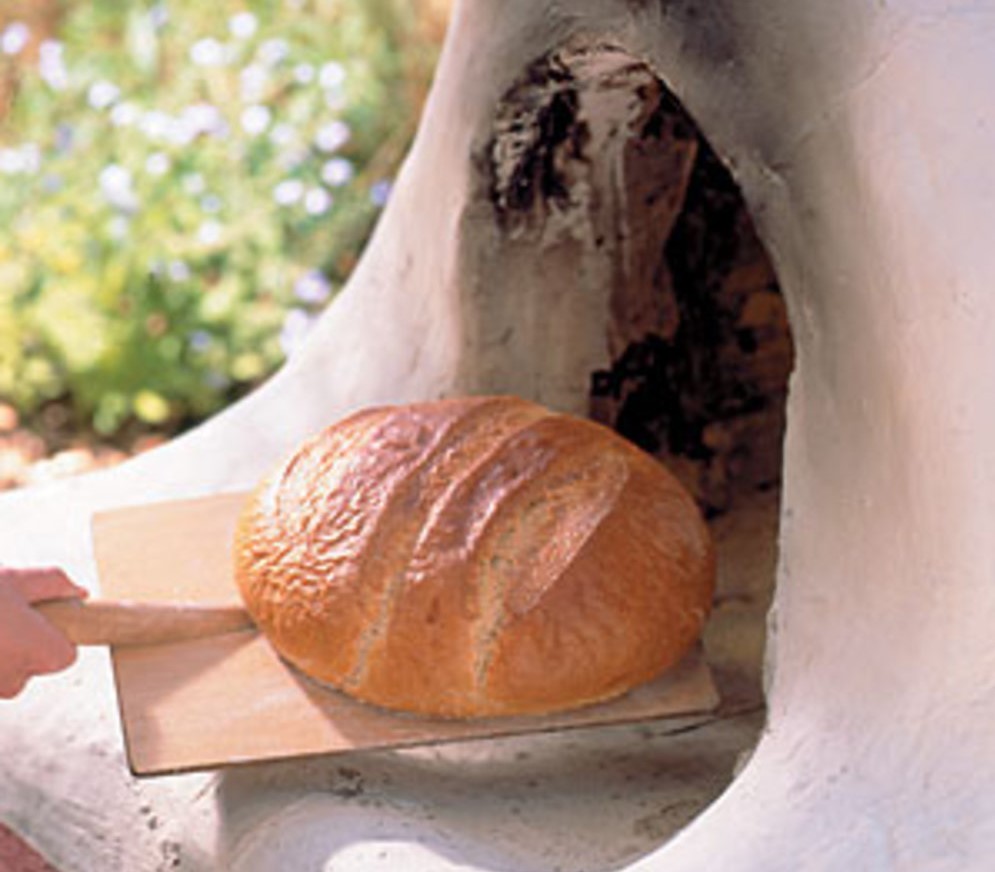
Adobe bread – also called oven bread, is a type of bread typical of the Pueblo people of the Southwestern United States. The bread is often shaped like animals typical of the region. The dough often contains meat, vegetables, seeds, or nuts. The bread is baked in a beehive-shaped outdoor adobe oven (called an horno). The basic dough is made with yeast, flour, salt, warm water, and a sweetener such as honey or sugar.
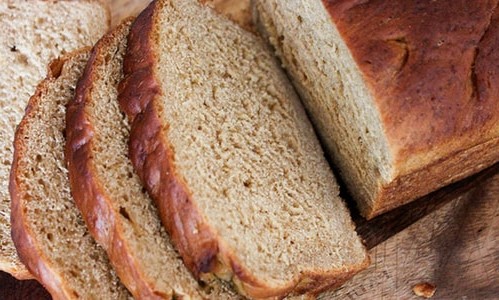
Anadama bread – is an old-fashioned yeast bread of New England in the United States made with wheat flour, cornmeal, molasses and occasionally rye flour.
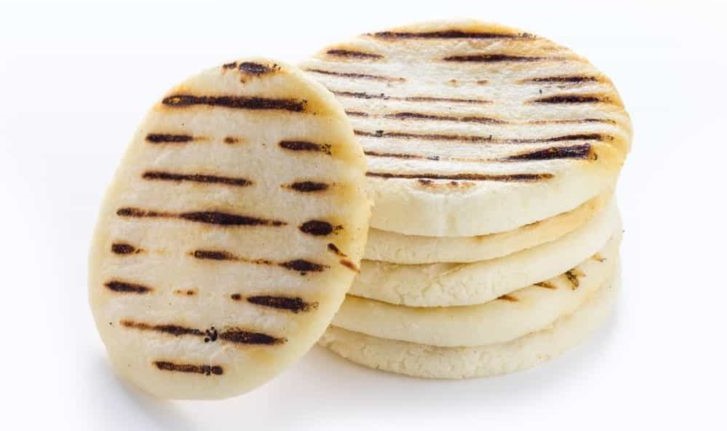
Arepa bread – Mostly eaten in Colombia and Venezuela, this bread is made of cornmeal. Flat and round. You can bake it, grill it, or fry it. Perfect for stuffing with various fillings such as ground beef and black beans. Since it is not made with wheat, Arepa bread is naturally gluten-free.
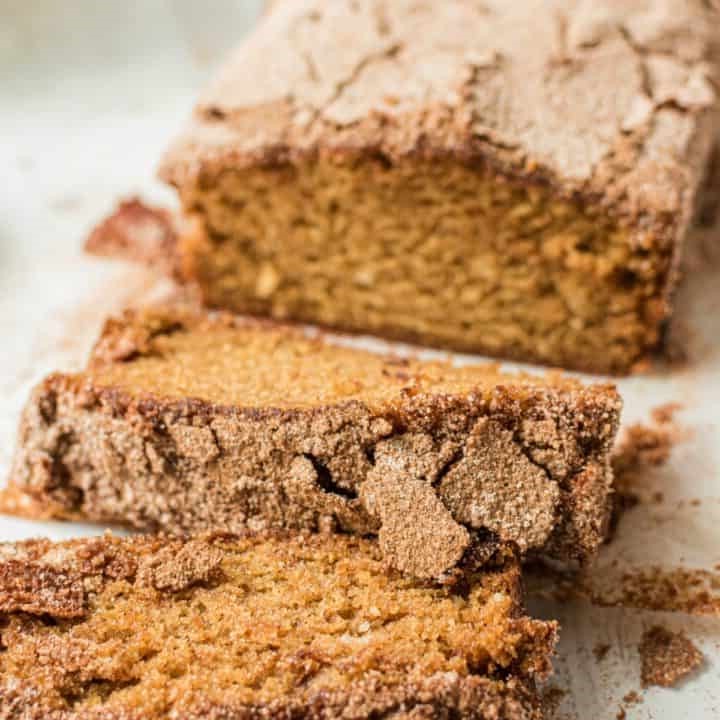
Amish friendship bread – type of sweet bread made from a sourdough starter that is often shared in a manner like a chain letter, among friend and neighbors. The sweet, cake-like Amish cinnamon bread is a common bread that is made from this starter; it is a simple, stirred quick bread that includes a substantial amount of sugar and vegetable oil, with a mild cinnamon flavor. It has characteristics of both pound cake and coffee cake. The flavor of the finished product can be altered by cinnamon being omitted.
B:
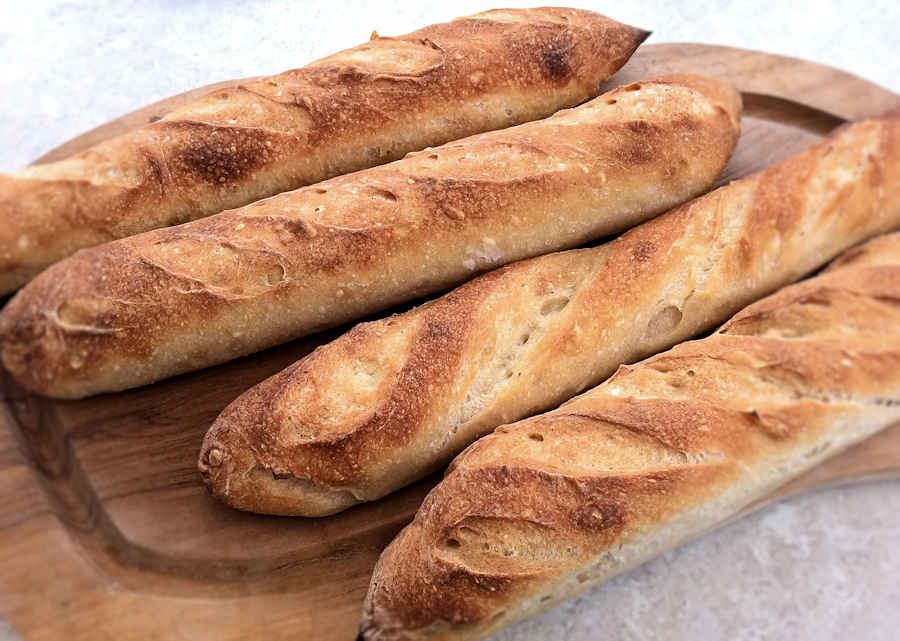
Baguette – The word baguette simply means “wand”, “baton” or “stick”. the most famous bread in France, first appeared in the history, in Eighteenth Century. It has then more primitive form than the one we recognize today as a baguette. The design itself experienced several refinements and variations before being (officially) given that name in 1920, and officially recorded as a type of bread. A baguette has a diameter of about 5 to 6 centimeters (2–2 1⁄2 inches) and a usual length of about 65 cm (26 in), although a baguette can be up to 1 m (39 in) long.
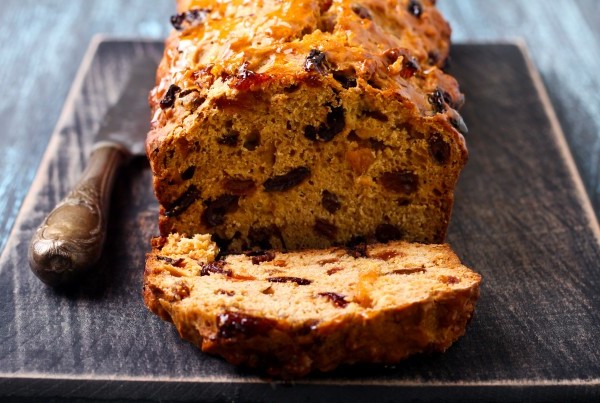
Bara Birth – Fruited bread from Wales (United Kingdom) of which there are many varieties, some made with yeast and others baking powder. Traditionally eaten just with butter.
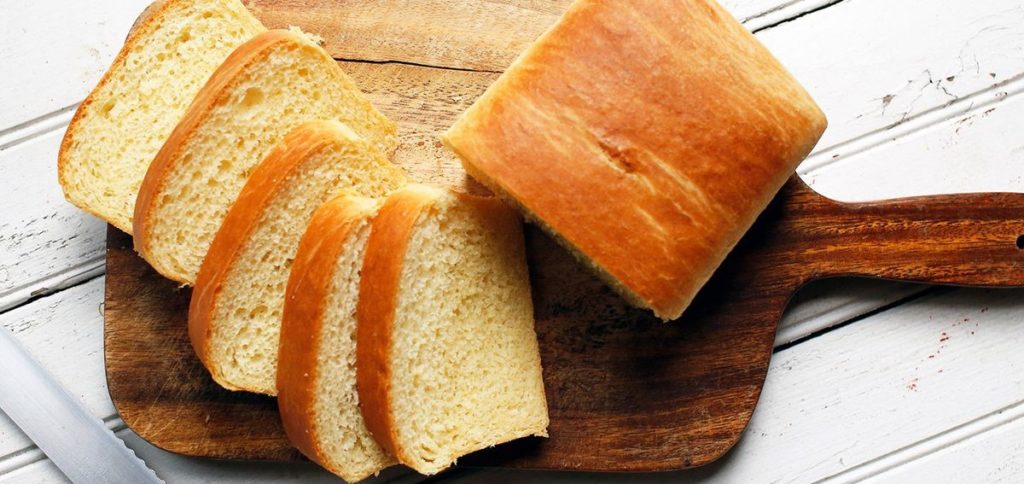
Brioche – Brioche is a bread of French origin that is like a highly enriched pastry, and whose high egg and butter content gives it a rich and tender crumb. This type of bread, or you can shape it into buns as well, is “light and slightly puffy”.
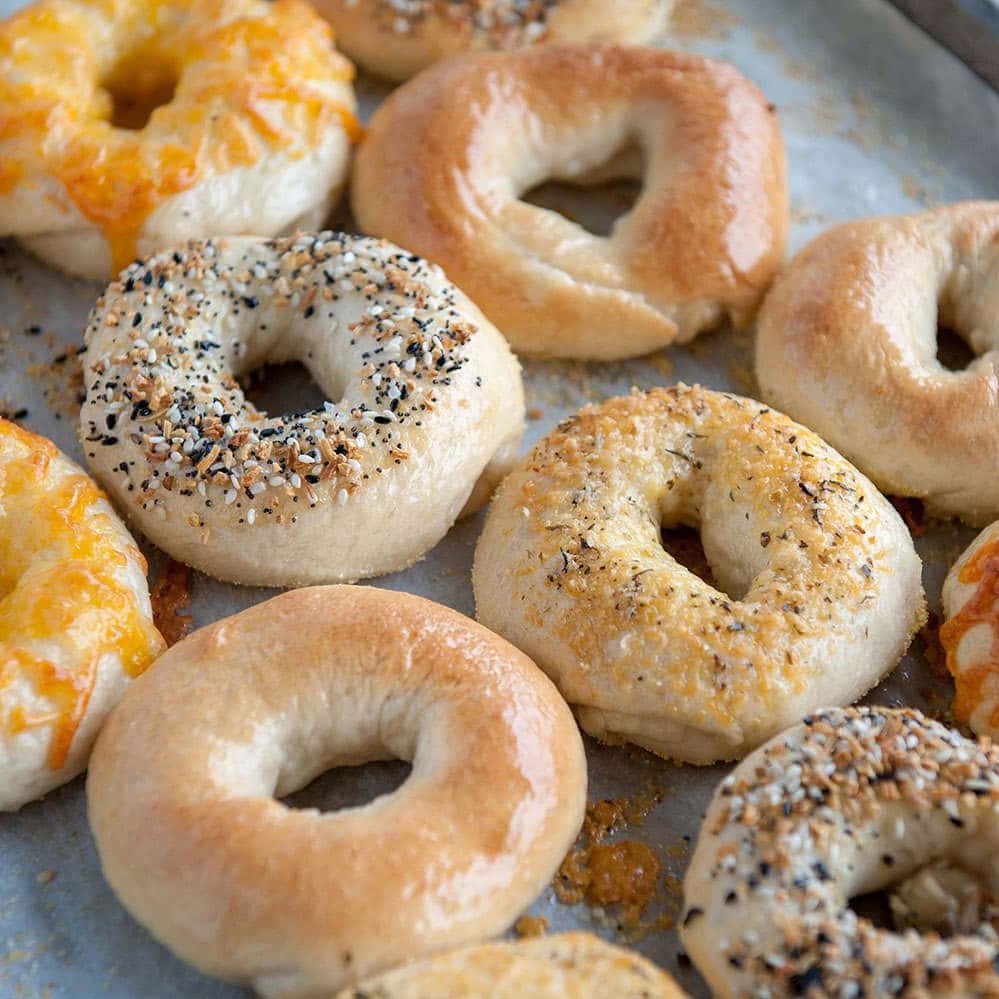
Bagel – Bagels nowadays is a breakfast staple in America, which was brought here by immigrants from Poland. They must be boiled in water for a short time, and they baked after that. This gives them that traditional shine on the top and keep the chewiness inside. They are round and have a hole in the center. The best part about buying bagels is their numerous types, such as sesame, onion, everything seed, cinnamon, or blueberry.
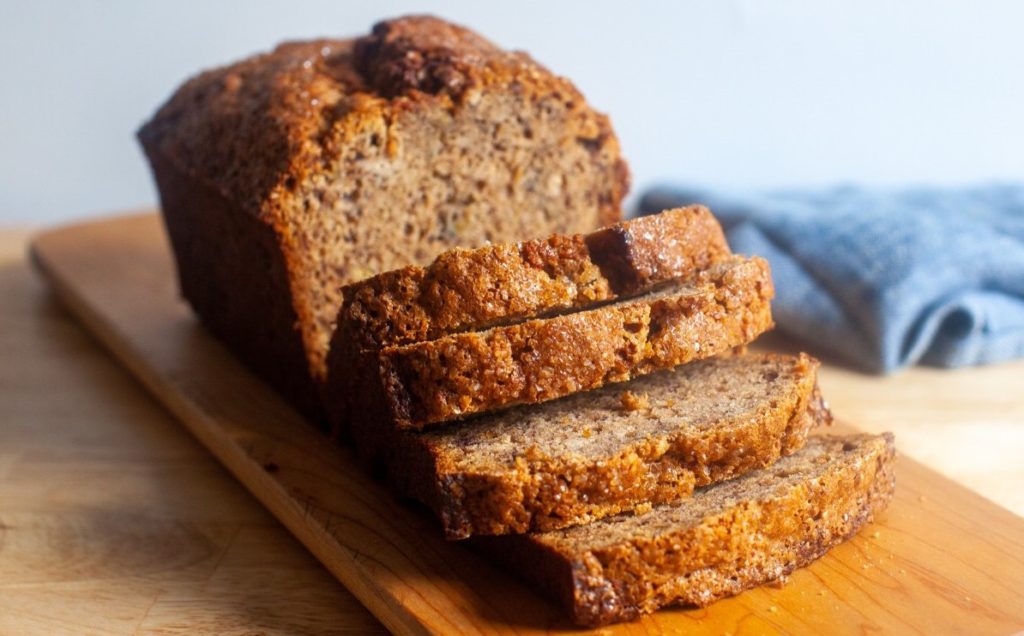
Banana bread – Banana bread is a type of bread made from mashed bananas. It is regularly a moist, sweet, cake-like quick bread. Usually eaten as a desert food rather than traditional bread.
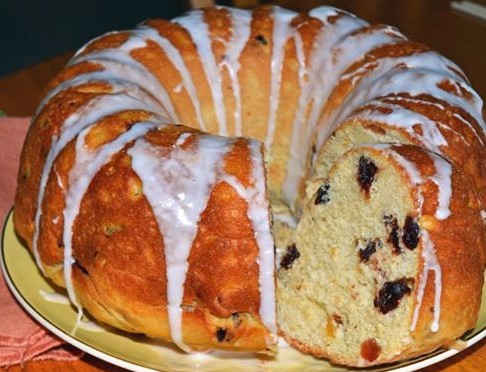
Babka (Polish) – Babka is a sweet Polish yeast bread, like Italian panettone, that can be made with rum-soaked raisins and iced or left plain. It is an Easter favorite. In fact, every Eastern European country has its own traditional Easter bread. Traditional babka is made with a staggering number of egg yolks and requires two or more yeast risings.
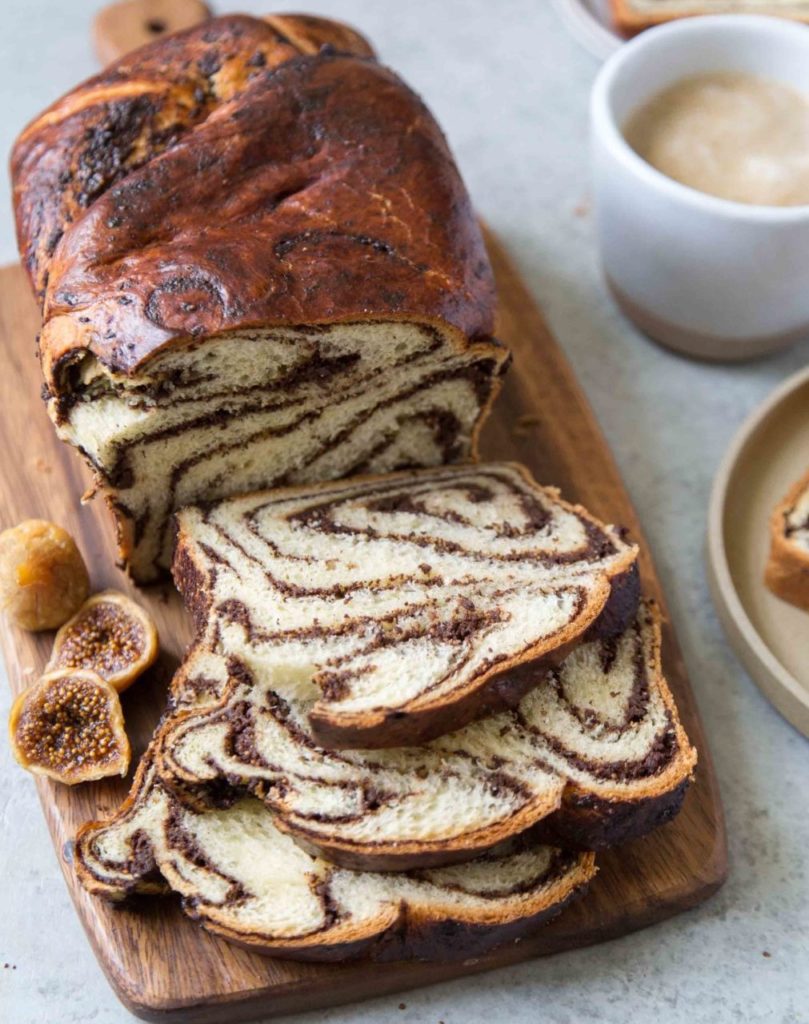
Babka (American) – extremely popular in North American cities with large Jewish populations. The rich, buttery, swirly loaf of yeasted dough, entwined with ribbons of filling. The most popular filling is chocolate, but cinnamon and hazelnuts are also used quite often. As if the buttery dough and delicious chocolate filling are not rich enough, this version, typically baked in a high loaf pan, is often finished with a generous layer of streusel topping, which results in a truly decadent dessert that.
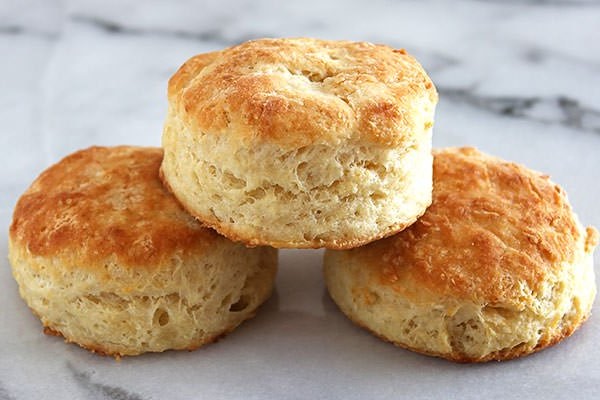
Biscuit – In the United States and some parts of English Canada, a “biscuit” is a quick bread, somewhat like a scone, and usually unsweetened. Leavening is achieved by using baking powder or, when using buttermilk, baking soda. Across the pond, in United Kingdom nations and Ireland, a biscuit is a small baked product that would be called either a “cookie” or a “cracker”. Biscuits are rather hard and may be savory or sweet, such as chocolate biscuits, digestives, hobnobs, ginger nuts, rich tea, shortbread, bourbons.
C:
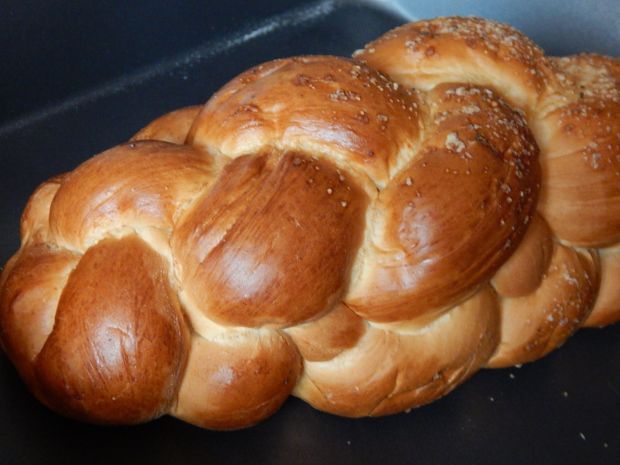
Challah – Challah is a special bread in Jewish cuisine, usually braided and typically eaten on ceremonial occasions such as Shabbat and major Jewish holidays. This rich bread is made from dough, with eggs and butter. Need to be proofed. Braided into traditional shape and let to rise.
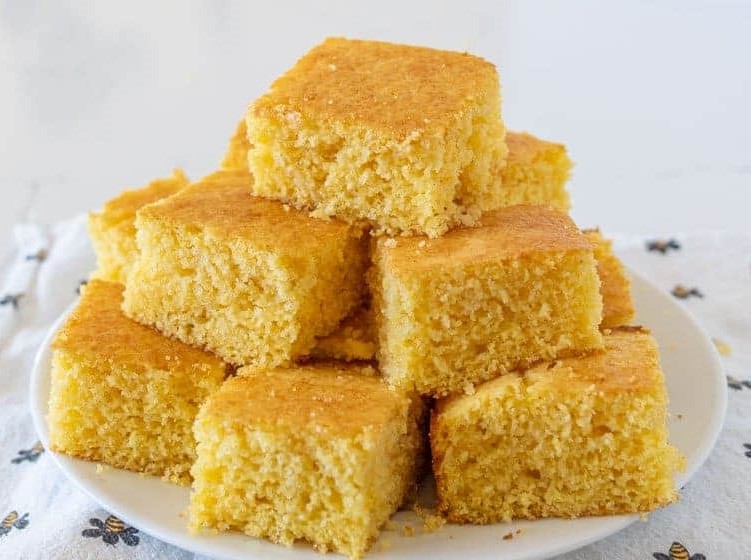
Cornbread – quick bread containing cornmeal, and a Native American cuisine. They are usually leavened by baking powder. In most cases baked in cast iron skillets, in the oven.
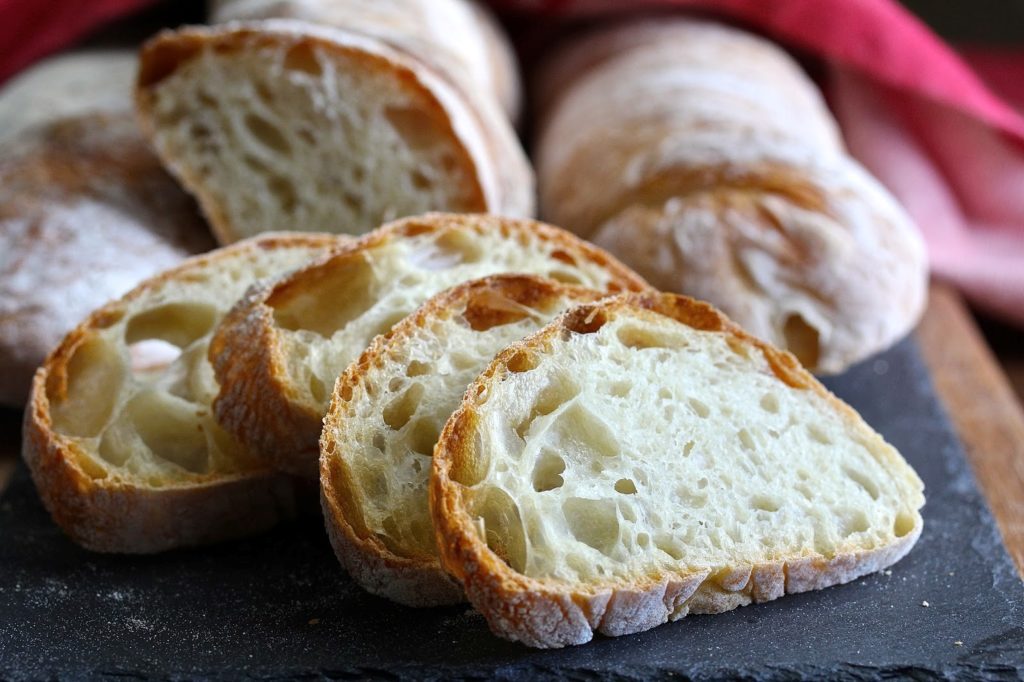
Ciabatta – Ciabatta is the Italian word for “slipper”, and this Italian-made bread made entirely of just a few basic ingredients, including water, salt, yeast, and wheat flour. Depending on where in Italy you find this type of bread, its crust and even its texture can vary, but the main ingredients are the exact same in every loaf you find. Ciabatta bread is perfect for paninis and sandwiches, as well as many other dishes.
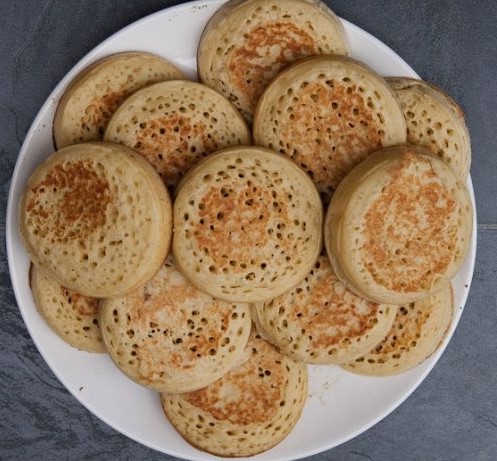
Crumpet – A crumpet is a small griddle cake made from an unsweetened batter of water or milk, flour, and yeast, eaten in the United Kingdom, the Republic of Ireland, Canada, and Australia.
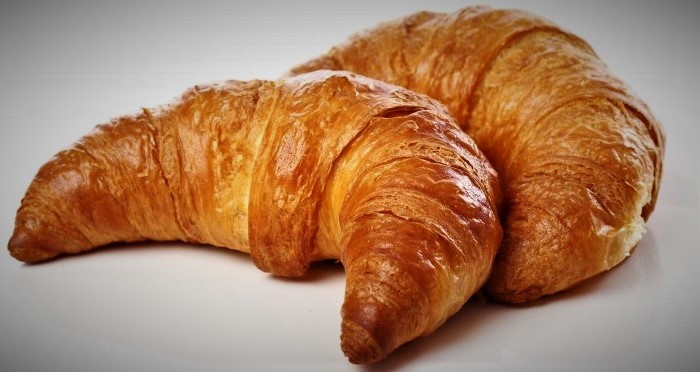
Croissant – A croissant is a buttery, flaky pastry of Austrian origin, named for its historical crescent shape. Croissants are made of a layered yeast-leavened dough. The dough contains huge amount of utter, to create those characteristic layers.
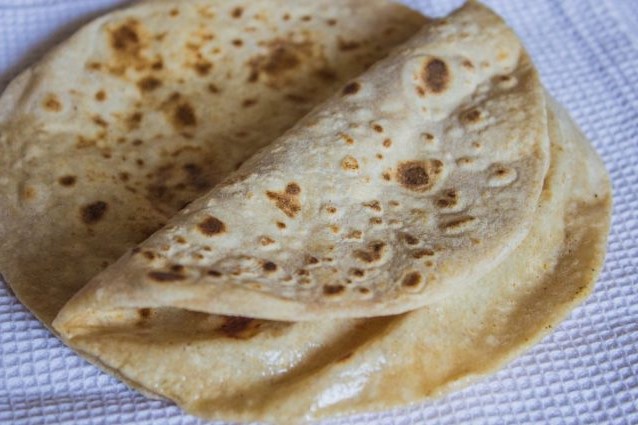
Chapati – A popular Indian flatbread, Chapati bread is usually grilled until it gets a freckled appearance. You can eat it with vegetables or lentils, or even make a sandwich with it. It is usually made with whole-wheat flour and cooked with no oil.
D:
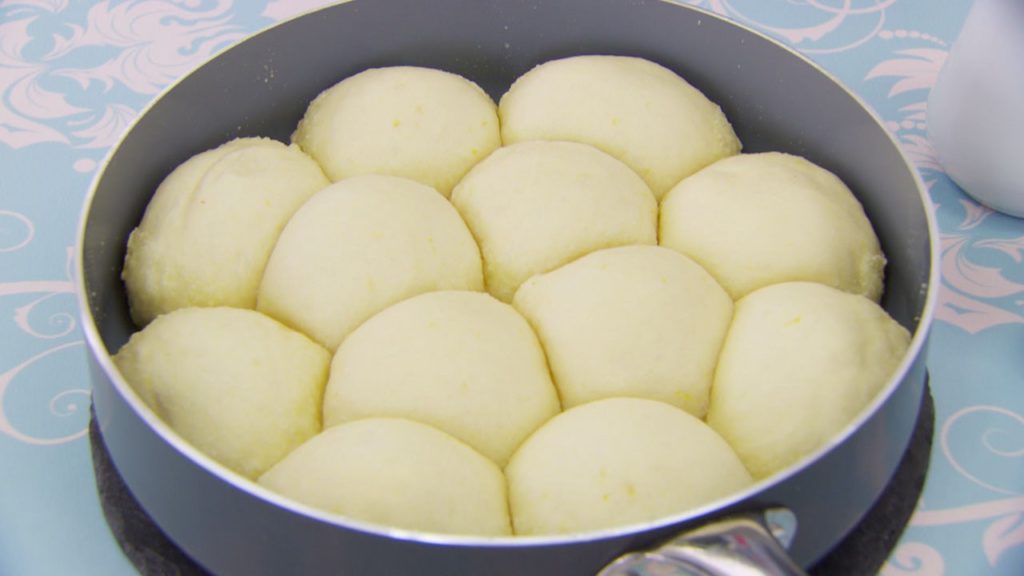
Dampfnudel – Dessert German-style, these little dumplings, or “dampfnudel”, can be sweet or savory. They are made from a dough comprised of white flour, water, yeast, salt, butter, or margarine, and sometimes also eggs and a little sugar. The dough is formed into balls about the size of an egg or a fist, left to rise and then cooked in a closed pot. Traditionally poached to perfection and bathed in vanilla custard – a comfort-food classic.
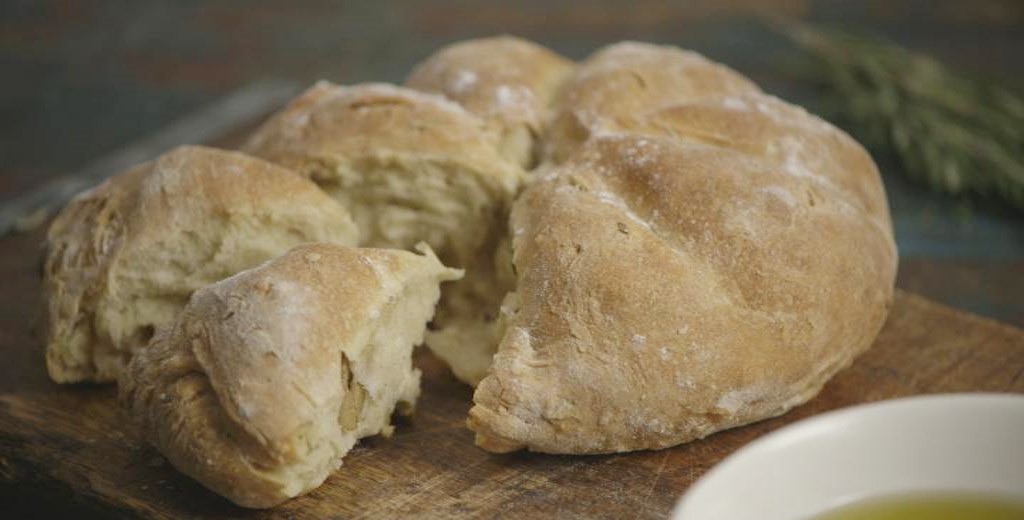
Damper bread – is a traditional Australian soda bread, historically prepared by early travelers through Australia. Damper is a dough of wheat-flour-based bread and water, with some butter if available, lightly kneaded and baked in the coals of a campfire in a camp oven. Damper is an iconic Australian dish.
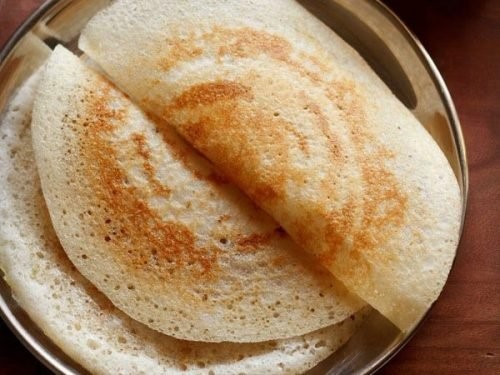
Dosa – Rice pancake, originating from South India, made from a fermented batter. It is cooked on an earthen pan that has a rounded bottom. It is fluffy and appears like a bread. It is cooked without the use of oil.
E:
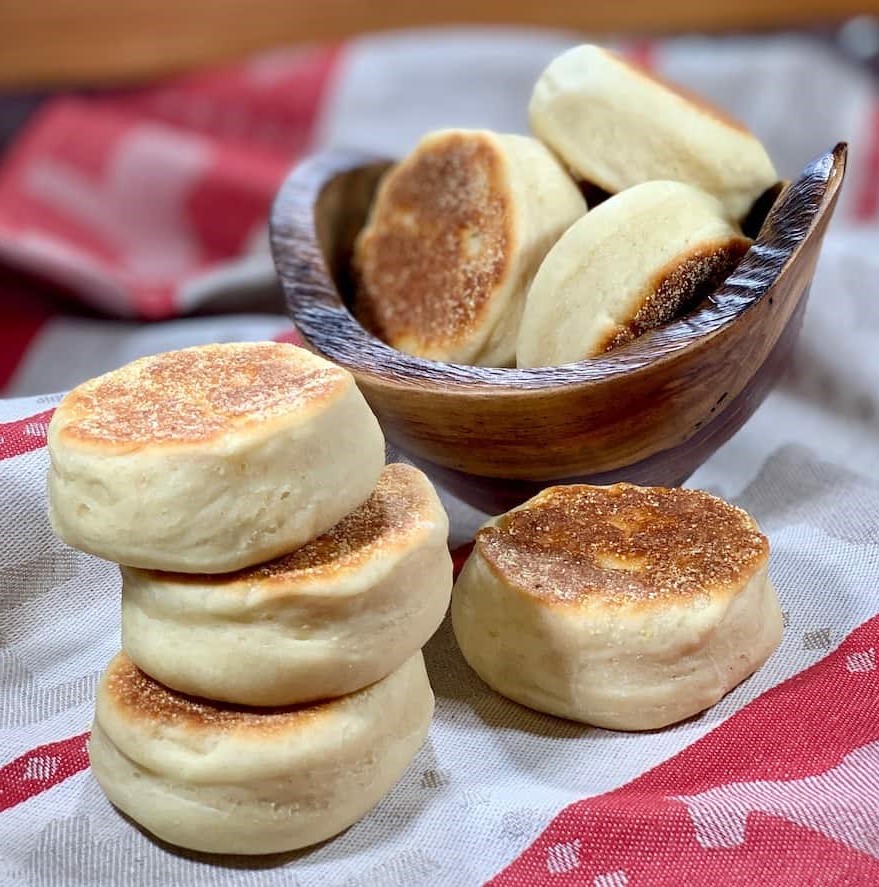
English muffin – These are small, round, flat types of bread that can be made of either white or whole wheat. You can eat them with poached eggs, bacon, or even a Hollandaise sauce. Often, English muffins are healthier than many other types of muffins and bread, but the American version is a little different than the original English muffins, so a little research might be in order.
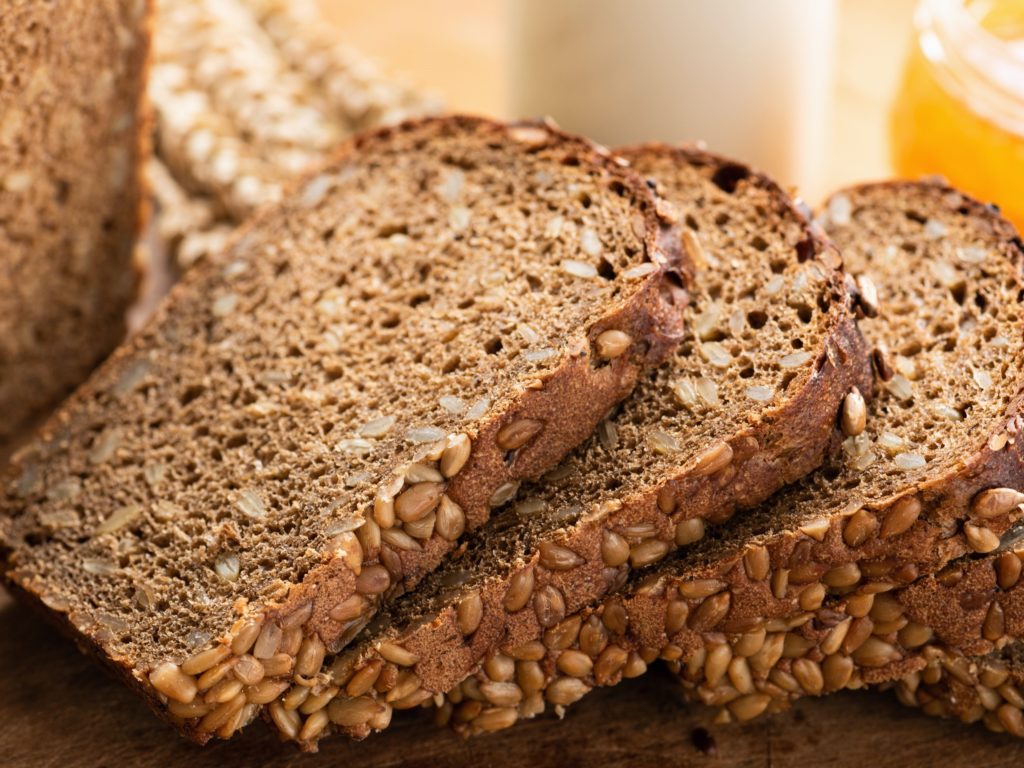
Ezekiel Bread – products are crafted in the likeness of the Holy Scripture verse Ezekiel 4:9 to ensure unrivaled honest nutrition and pure, delicious flavors. “Take also unto thee wheat, and barley, and beans, and lentils and millet, and spelt and put them in one vessel…” Ezekiel 4:9. It’s this special, unique combination of 6 grains and legumes that harvests benefits beyond what we normally expect from our breads, pastas, cereals, and other foods.
F:
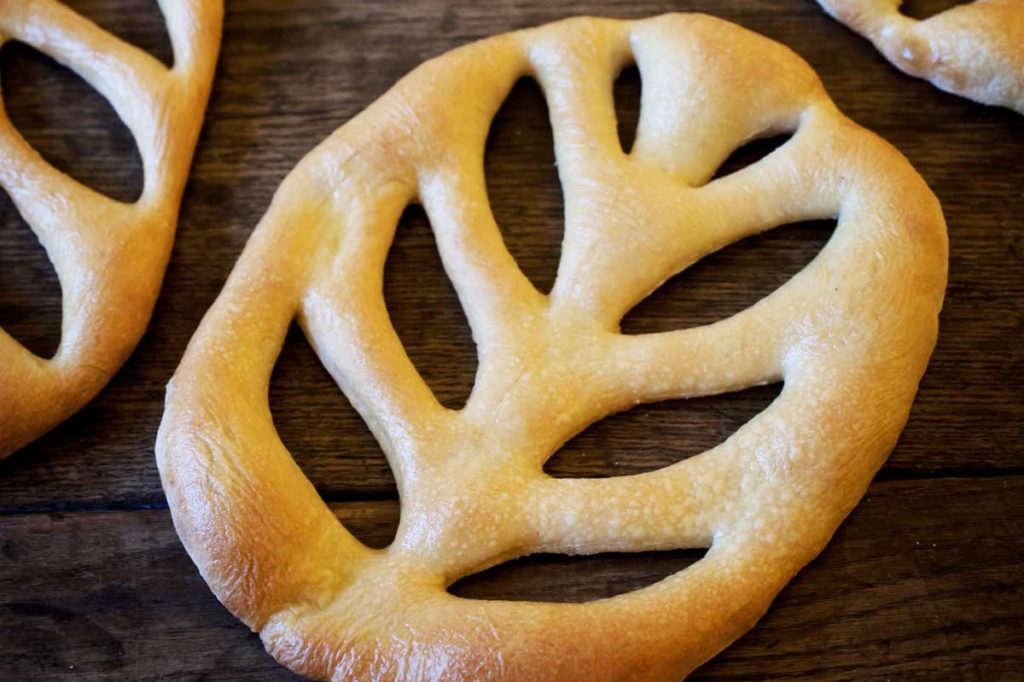
Fougasse – In French cuisine, fougasse is a type of bread typically associated with Provence but found in other regions. French flatbread that is like Italian focaccia. The crisp crust gives way to a spongy, slightly chewy crumb. The unique design also adds to its charm. Fougasse is traditionally shaped to look like a rustic leaf, with freeform slits mimicking the veins and stem of the leaf.

Focaccia – Rosemary Pizza bread. Focaccia is a type of flat bread made in similar way as pizza dough, traditionally seasoned with olive oil, herbs, vegetables and/or cheese. Focaccia can be used as a side to many meals or as sandwich bread, or as a part of antipasto platter. Focaccia al rosmarino is a most popular style of flatbread in Italian cuisine prepared using focaccia dough, rosemary, olive oil and salt, sea salt or kosher salt. Whole fresh rosemary leaves are used after baking, sprinkled with salt, and drizzled with olive oil.
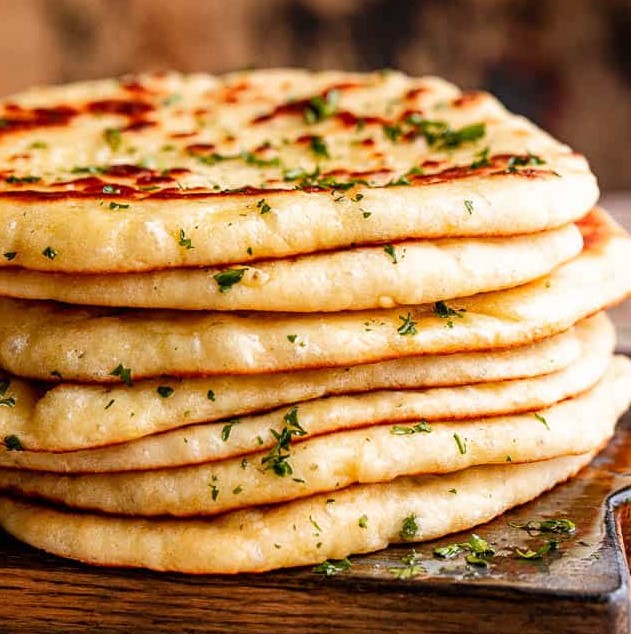
Flatbread – A flatbread is a bread made with flour, water, and salt, and then thoroughly rolled into flattened dough. Many flatbreads are unleavened, although some are leavened, such as pizza and pita bread.
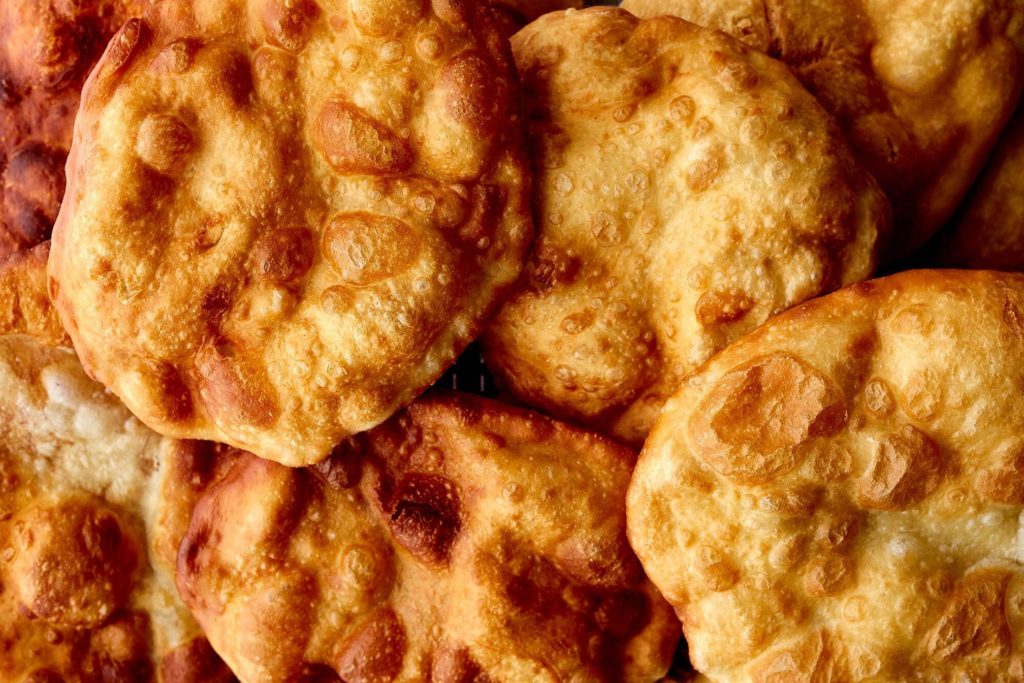
Frybread (fry bread) – is a flat dough bread, fried or deep-fried in oil, shortening, or lard. Made with simple ingredients, frybread can be eaten alone or with various toppings such as honey, jam, powdered sugar, venison, or beef. Frybread can also be made into tacos, like Navajo tacos.
G:
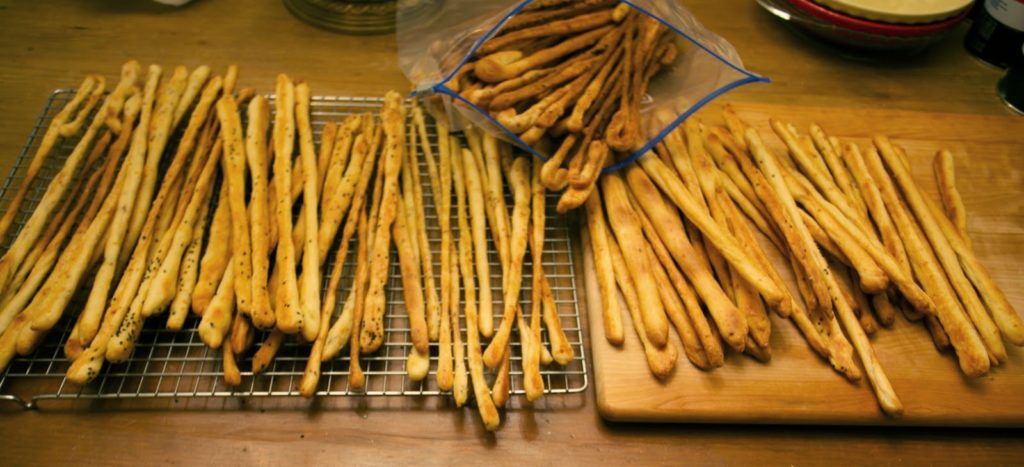
Grissini – are the long, thin, and very crispy bread sticks. Traditionally served with the breadbasket in Italian restaurants. They can be flavored with various herbs and spices and with Sesame seeds. They originated in Piedmont but are now common everywhere in Italy and even abroad.
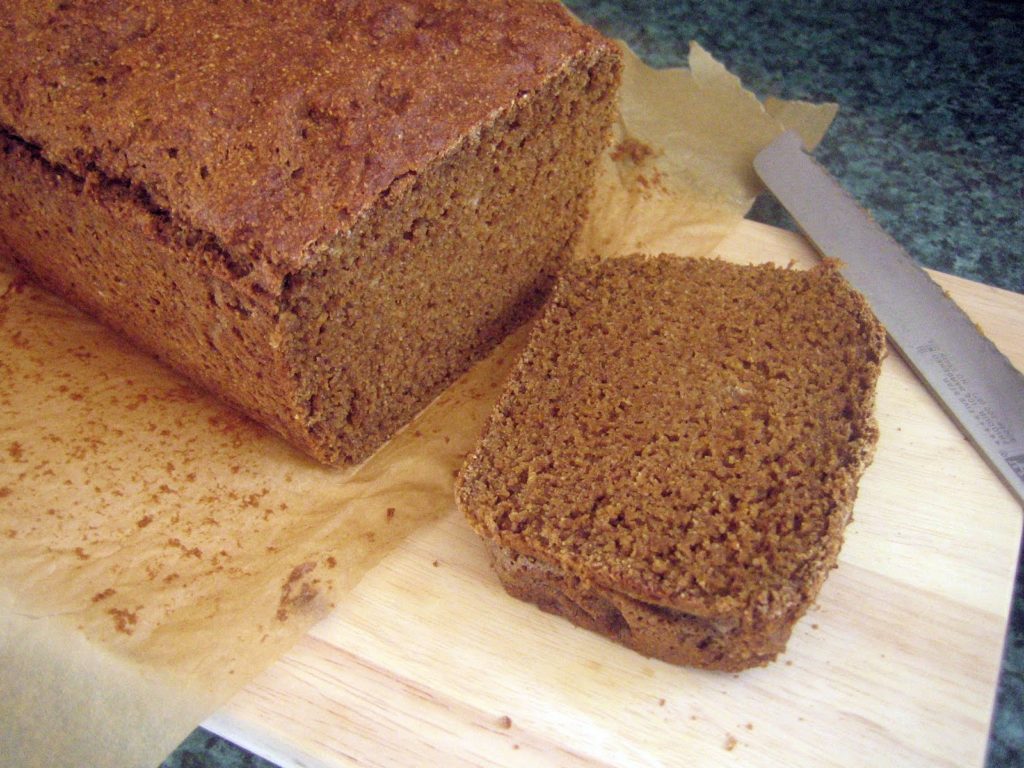
Graham bread – Invented in 19th-century German reformer who was propagating healthier way of eating and driving. Like Graham crackers, Graham bread is high in fiber and made from graham flour free from the chemical additives that were common in white bread at that time such as alum and chlorine. He argued that these chemical additives were unwholesome.
I:
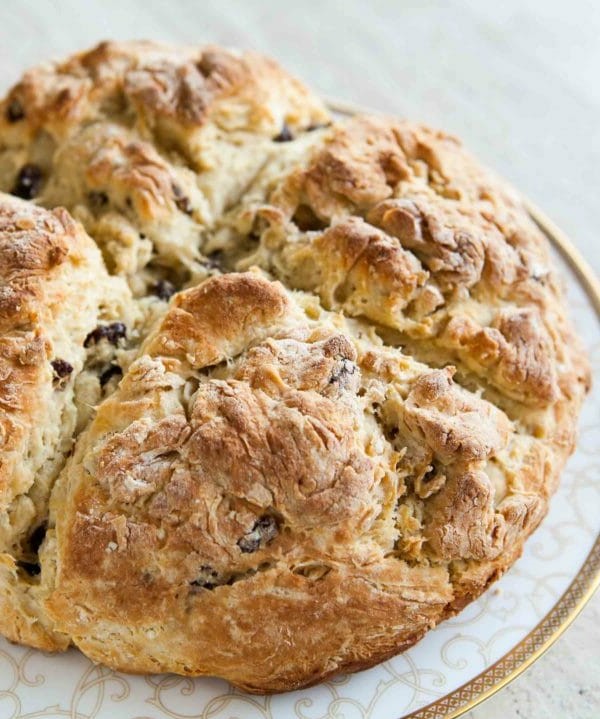
Irish soda bread – With ingredients that include buttermilk, salt, baking soda, and flour, this is a traditional type of bread in Ireland. It is also a bread that does not need time to rise, which means it can be made quickly and easily at any time.
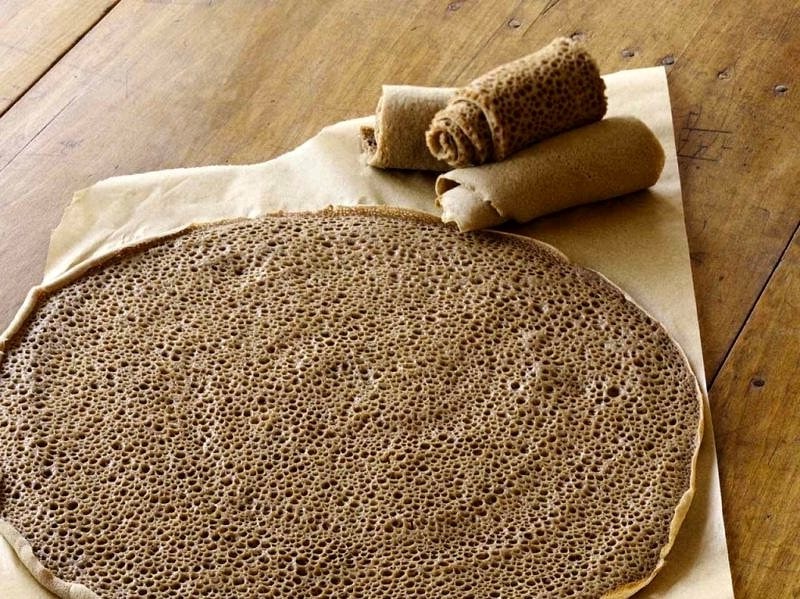
Injera – This is a sourdough type of bread with a spongy texture and a slightly sour taste. Injera bread is usually made from a tiny grain called teff, which comes from Ethiopia, and it is also used to scoop up the meats and stews that are typically placed on top of it.
K:
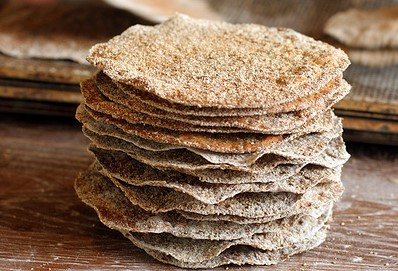
Knäckebröd Bread – This bread looks more like a cracker than regular bread, and it is made mostly of rye flour. It has a lot of fiber and can be served with cheese or any other type of food you love. The bread is dry and stiff, rectangular in shape just like many crackers. The grains can vary, and it can also include various herbs and spices. It is both nutritious and delicious.
L:
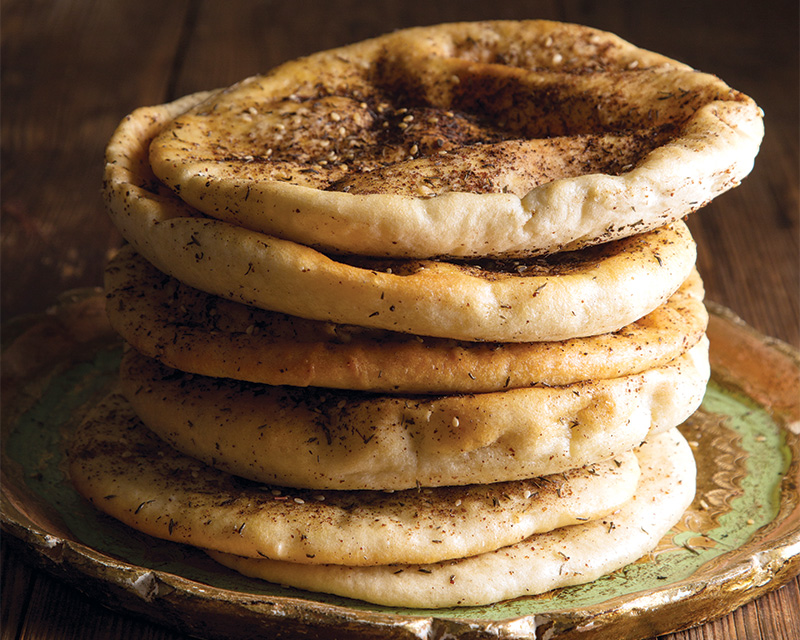
Laffa (Taboon bread) – Levantine flatbread. It is traditionally baked in a taboon oven or a tannur and is like the various tandoor breads found in many parts of Asia. It is used as a base or wrap in many cuisines and eaten with different accompaniments. Soft, slightly chewy Iraqi flatbread enjoys tremendous popularity in Israel as well, where it is used as a sandwich wrap, for scooping up dips.
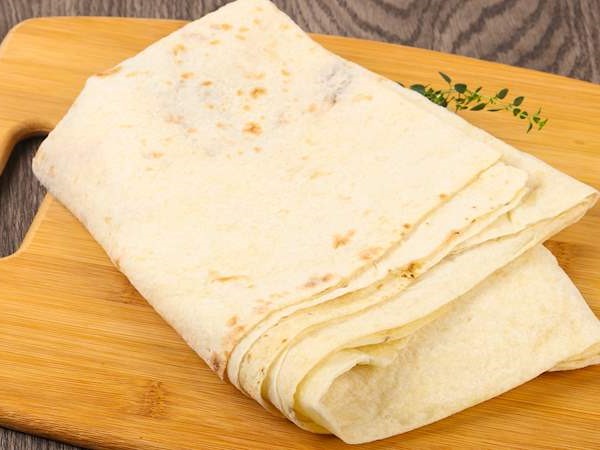
Lavash – Popular in areas such as Turkey and Iran, Lavash bread is a thin flatbread that is made only with flour, salt, and water. Low in fat, the bread is typically cooked in an oven and is softest when it is the freshest. You can also add poppy or sesame seeds to it, to bring some more flavor.
M:
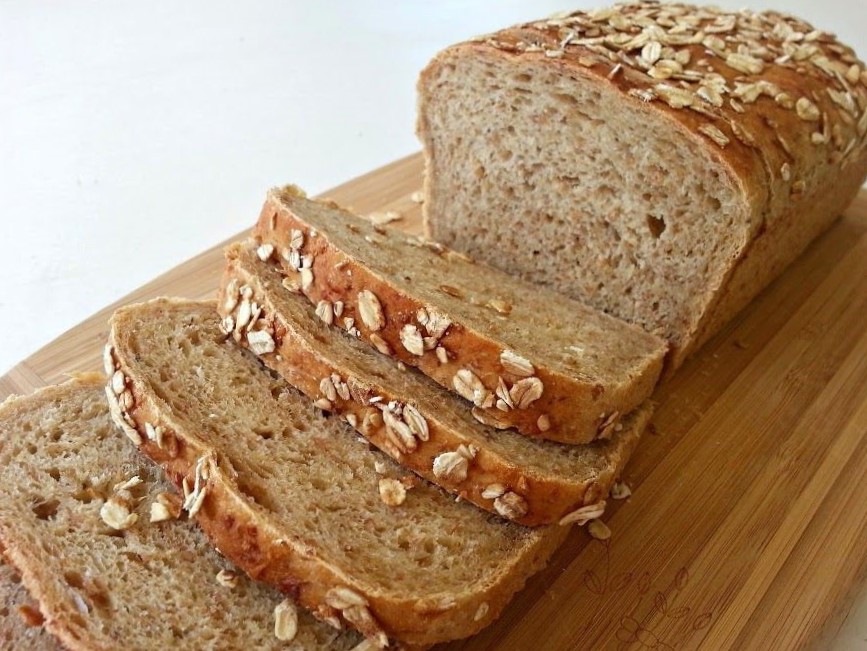
Multigrain – With a rich hearty flavor, multigrain bread usually uses grains such as oats, barley, flax, and millet, as well as others, so it is extremely healthy and delicious. It is perfect for your morning toast, sandwiches, or to dip in dressings or vegetable oil that has been sprinkled with herbs.
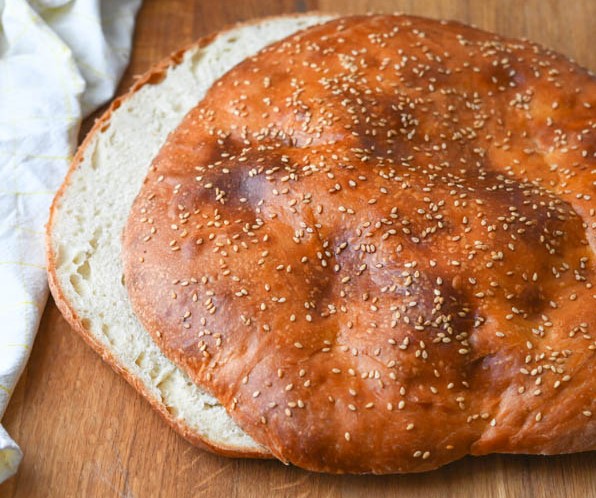
Muffaletta – (Muffuletta) is both a type of round Sicilian sesame bread. Also, the name of a popular sandwich that originated among Italian immigrants in New Orleans, Louisiana, using the same bread as its base.
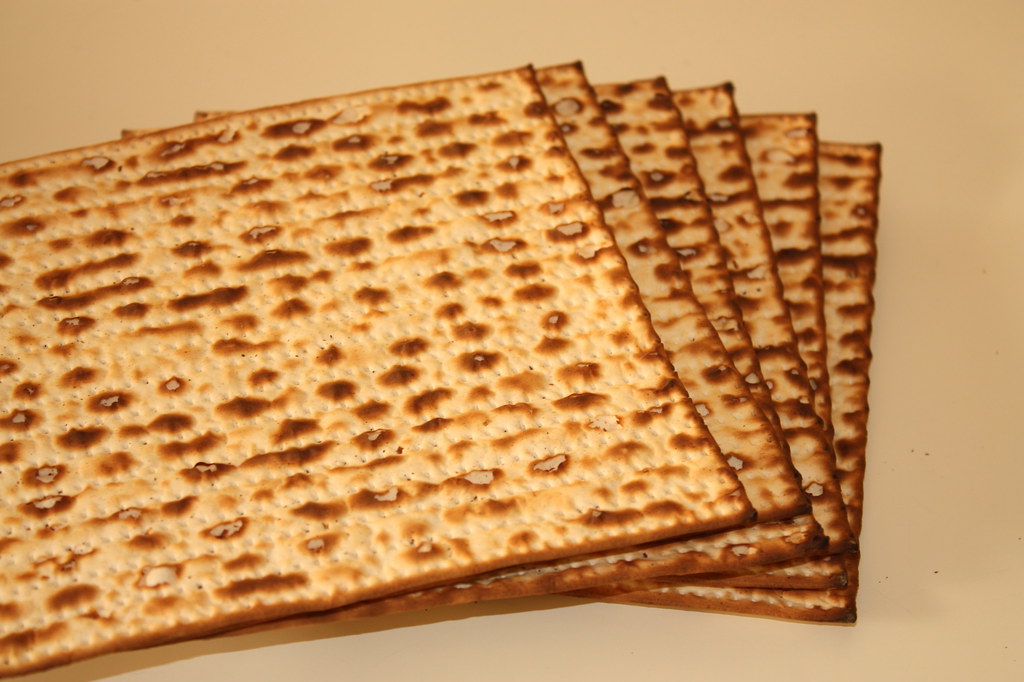
Matzo bread – is unleavened bread shaped like large square crackers. Used in many traditional Jewish dishes and on certain Jewish holidays, the bread is made of the five grains mentioned in the bible – wheat, barley, rye, oats, and spelt. It can come in either soft or hard form, and it is both tasty and important in Jewish tradition.
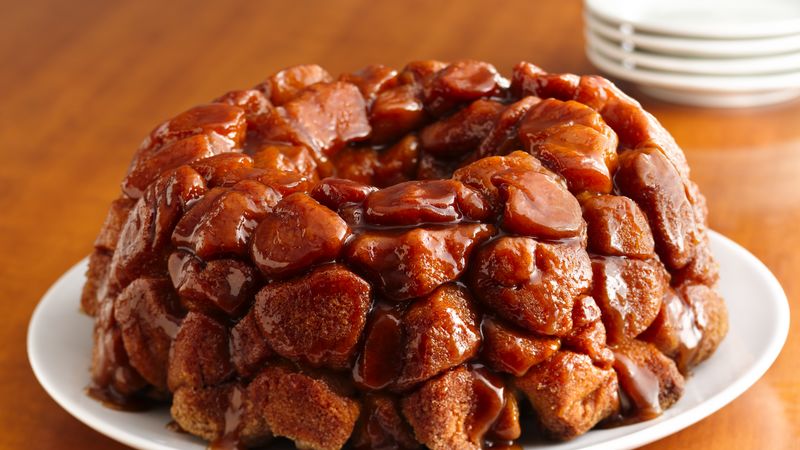
Monkey bread – Monkey bread is a soft, sweet, sticky pastry served in the United States for breakfast or as a treat. It consists of pieces of soft baked dough sprinkled with cinnamon. It is often served at fairs and festivals.
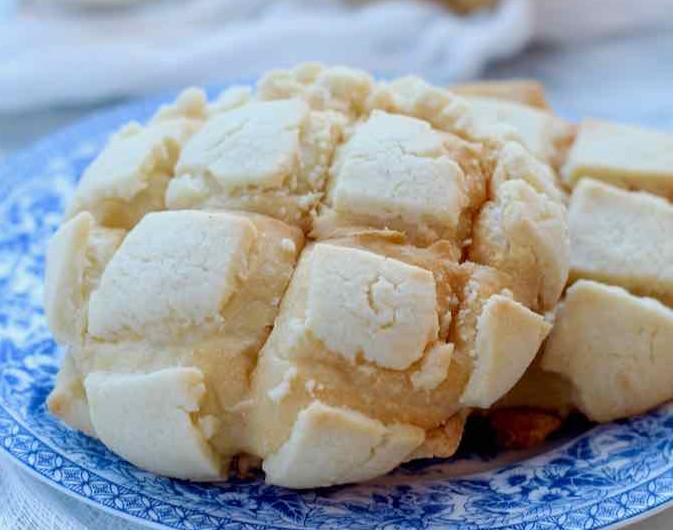
Melanpan – a Japanese bread made from enriched dough covered in a layer of cookie dough.
N:
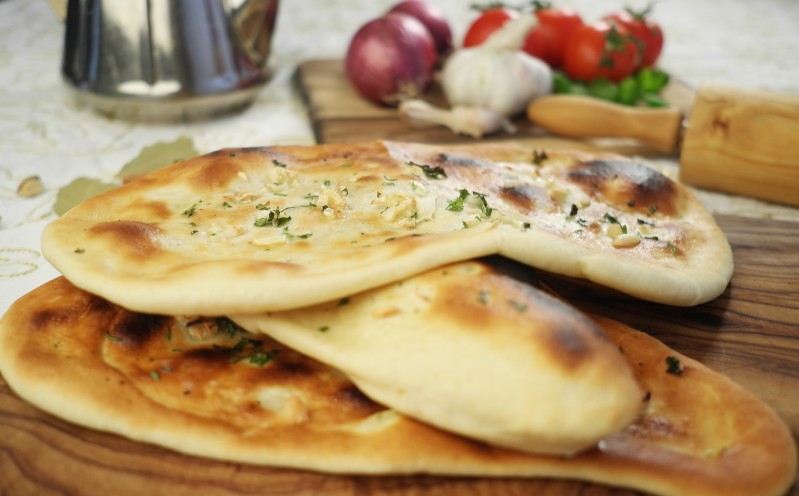
Naan – This is an oven-baked flatbread that uses yogurt as one of its main ingredients. They are normally brushed with butter before baking. They are common in many parts of Asia, and you can also find them in many of today’s supermarkets and farmers’ markets. Usually eaten with the meal.
P:
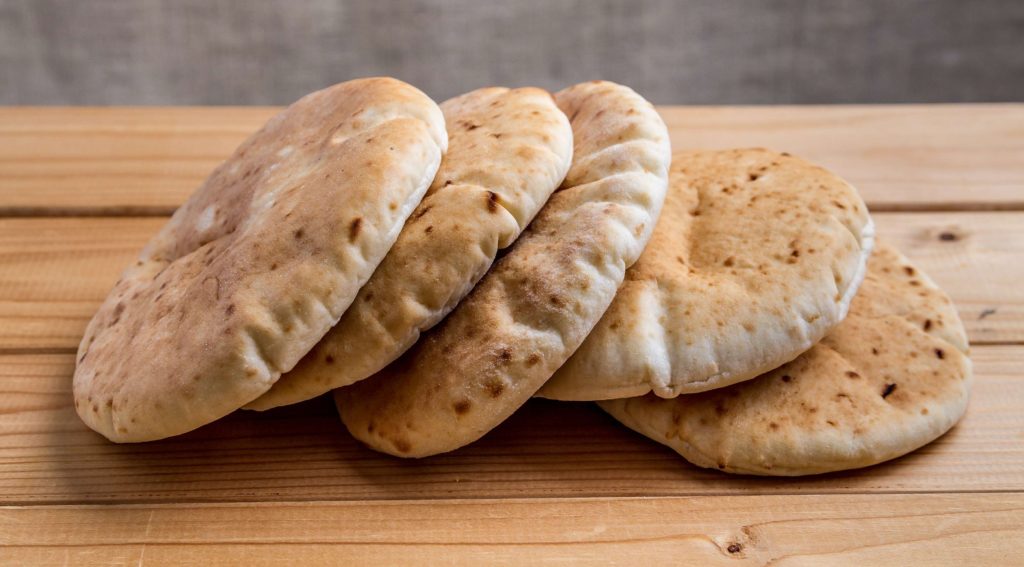
Pita – Pita bread originated in the Midwest and is cooked at extremely high temperatures, which makes the dough’s liquid escape. There is also a large air bubble in the center – the “pocket” of the bread – for stuffing with meat and other foods, and it is made mostly of wheat flour. It can be used in so many ways.

Portuguese sweet bread – Portuguese sweet bread is a bread made with milk, sugar, eggs, yeast, flour, and sometimes lemon peel to produce a subtly sweet lightly textured loaf or rolls. A slightly different recipe is made during Easter that is known as folar and often contains a hard-boiled egg.
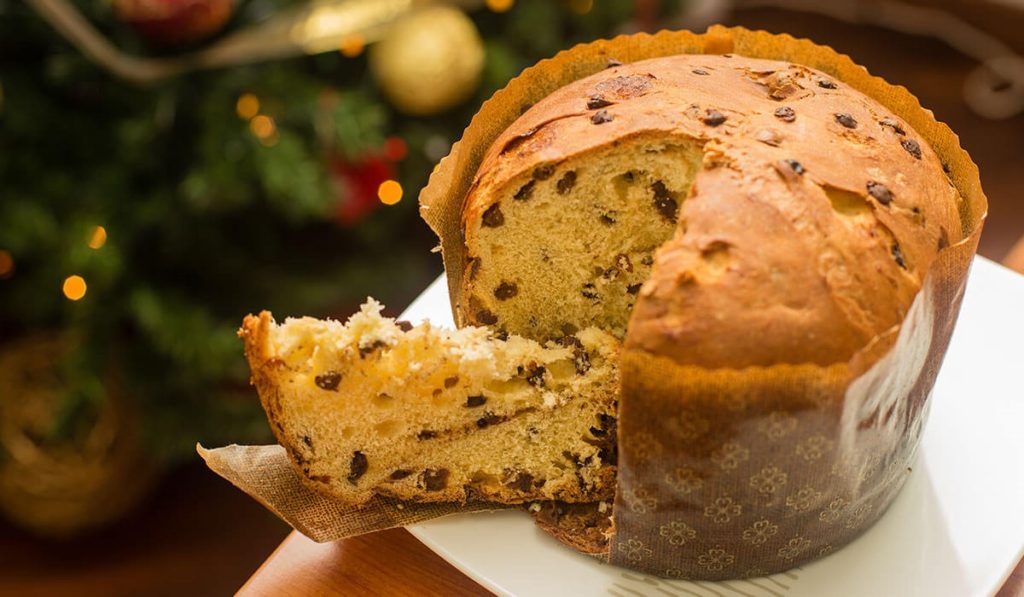
Panettone – A large leavened yeast cake stuffed with candied orange and lemon zest, as well as raisins, which are added dry (not soaked). Hardly any Italian family would go without having Panettone on the table at Christmas. Recently, new variations appeared on the market such panettone with chocolate, with champagne cream, etc. It is usually sold at Christmas and served as dessert or for breakfast. It is cut in vertical slices.
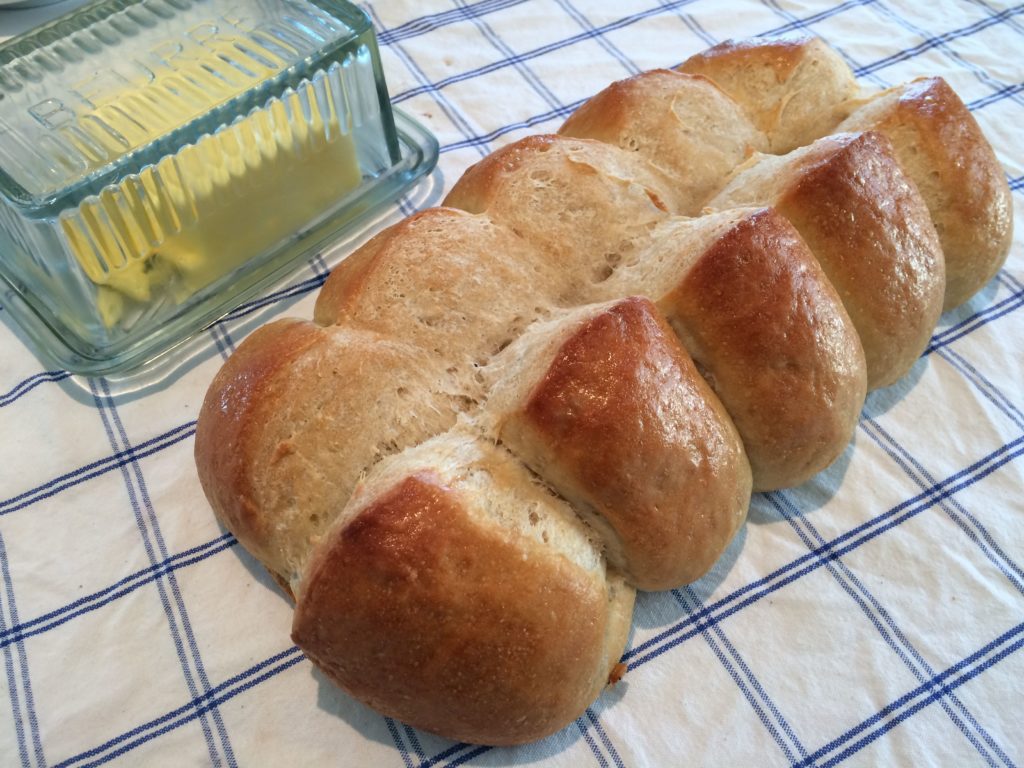
Pane Ticinese – This Swiss bread is distinguishable by its shape – it is composed of several small loaves or rolls made to be broken off by hand – and by the addition of oil to the dough, which makes the bread particularly soft.
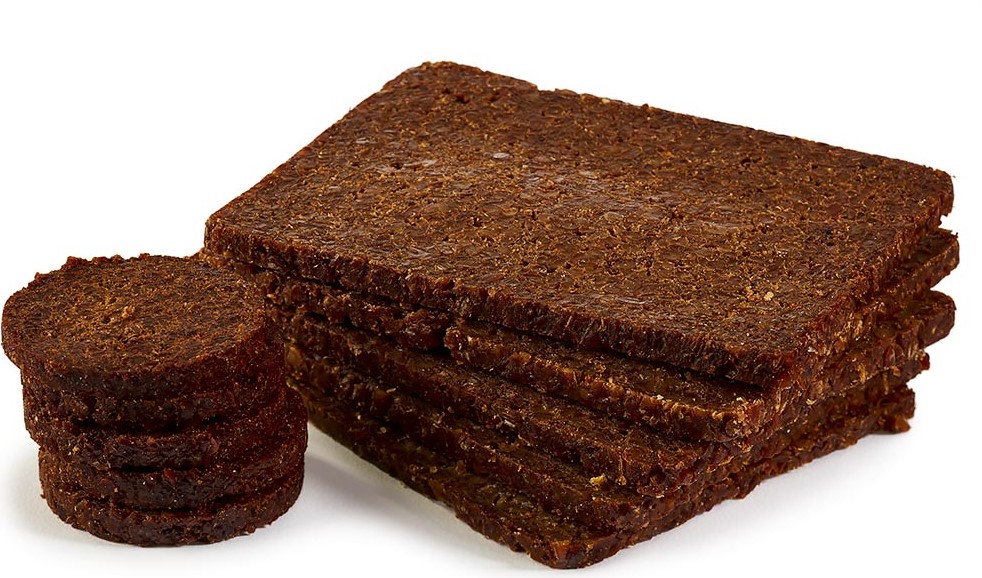
Pumpernickel (German) – Pumpernickel is a typically heavy, slightly sweet rye bread traditionally made with sourdough starter and coarsely ground rye. It is often made with a combination of flour made from rye as well as whole rye grains.
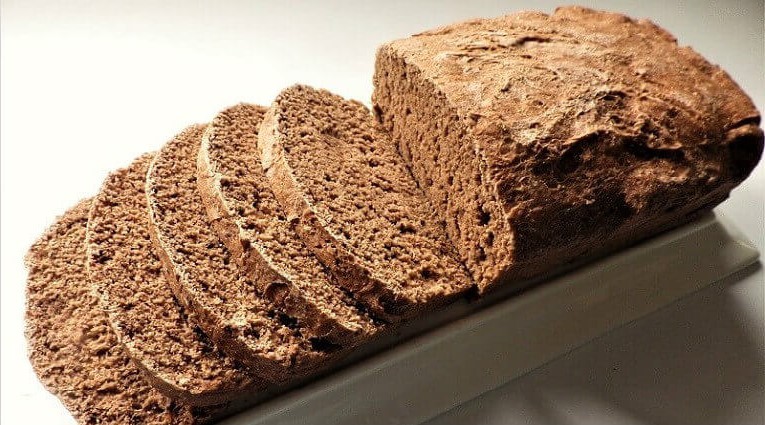
Pumpernickel (American) – American-style Pumpernickel Bread is really a wheat and rye bread unnaturally colored dark, rather than areal pumpernickel. It is often made in round, hand-formed loaves from refined rye flour, and wheat flour. The crumb is not dense, and the taste is quite different as well. Its production uses an ingredients such as coffee, molasses, or cocoa powder even to color it. Regular yeast is used to leaven it instead of a sourdough starter, to save time, and citric or lactic acid are used to imitate some of the taste that a sourdough starter would have given it. Many versions often add caraway seeds.
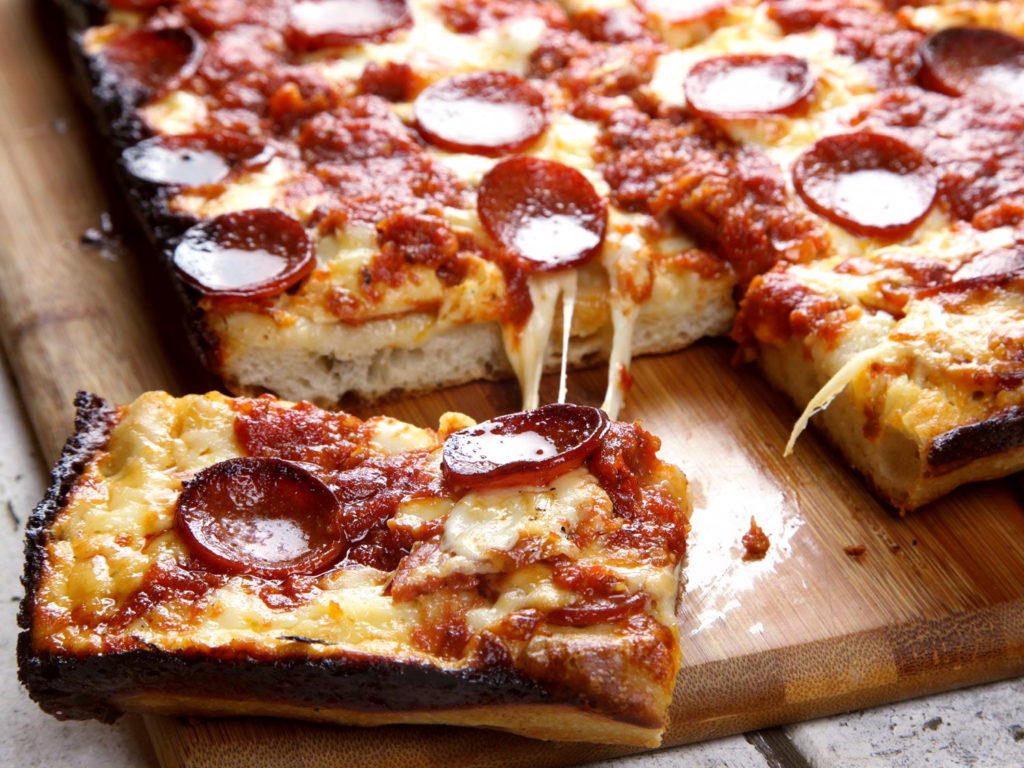
Pizza – is an oven baked, flat, usually round-shaped yeasty dough topped with ingredients such as tomato sauce, cheese, olive oil and endless varieties of other toppings. In Italy there are only two types of pizza: the Neapolitan – which is relatively tick on the outside perimeter and resembles a flat bread, and the Roman – which is much thinner and crustier. Neither of the two resembles the type of pizza found in the US.
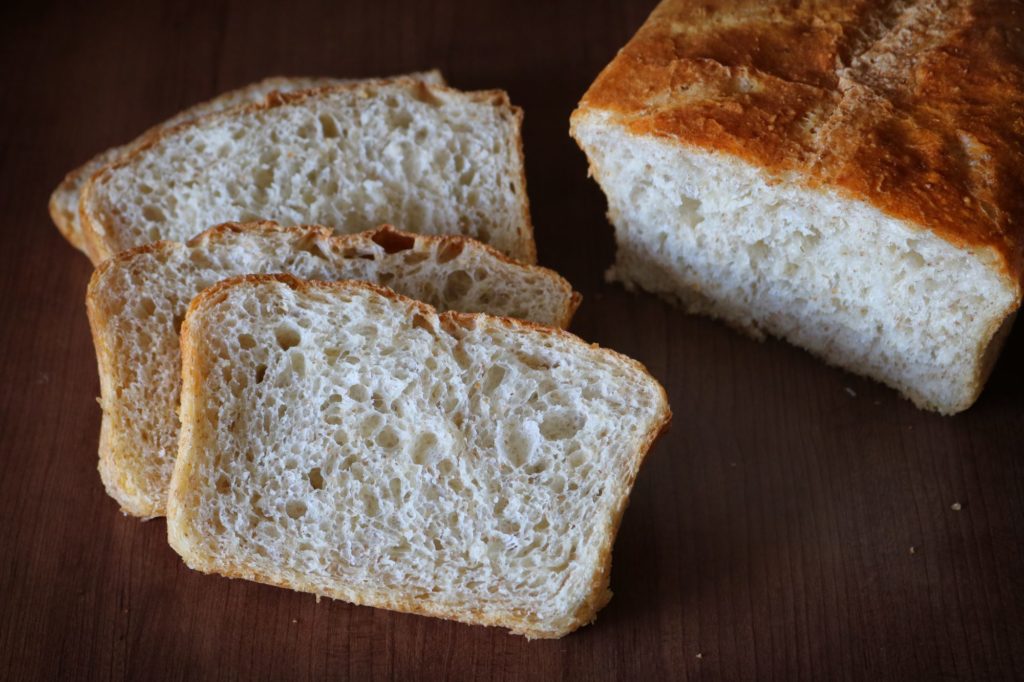
Potato bread – Potato bread is a form of bread in which potato flour or potato replaces a portion of the regular wheat flour. It is cooked in a variety of ways, including baking it on a hot griddle or pan, or in an oven. It may be leavened or unleavened and may have a variety of other ingredients baked into it.
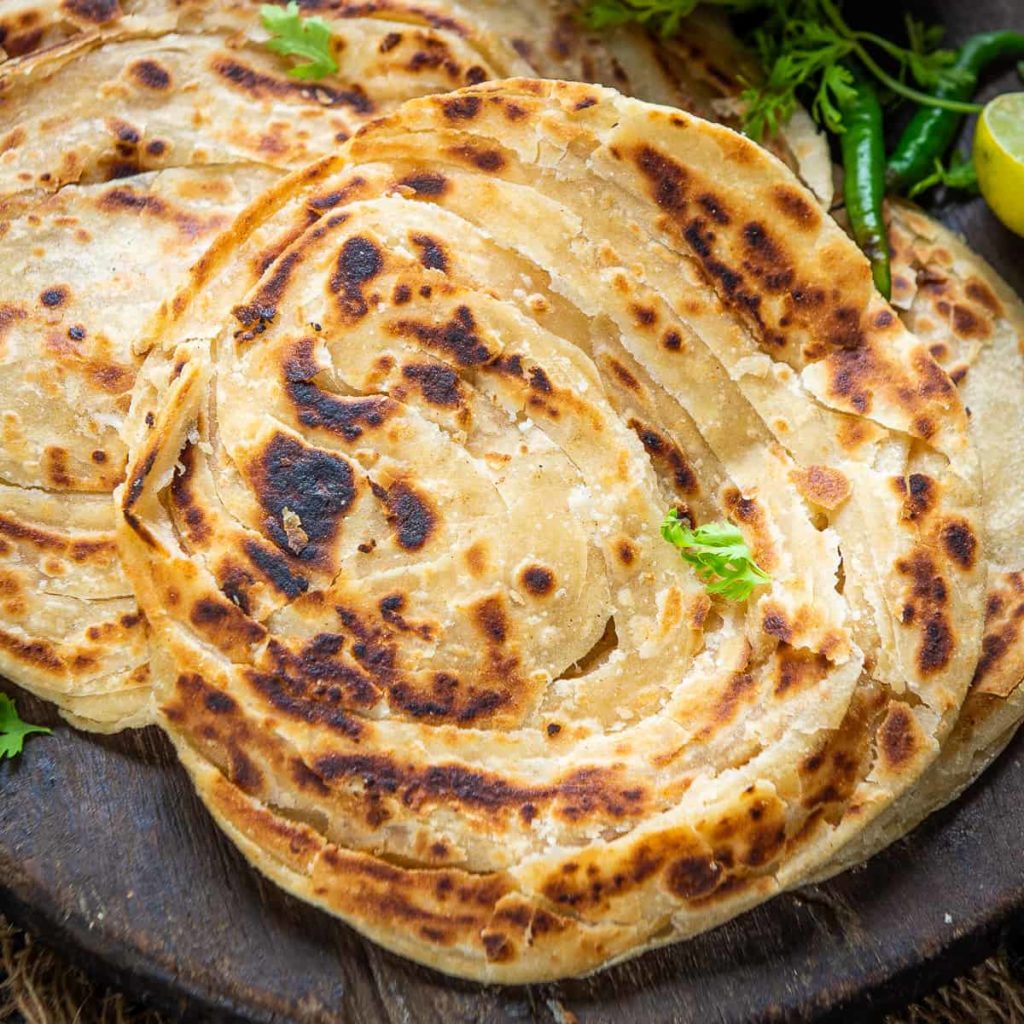
Paratha – Made from whole-wheat flour, Paratha bread is a layered Indian flatbread that is usually fried or cooked in oil. You can also bake them for a little healthier alternative, and you can eat them with vegetables, potatoes, onions, eggs, and many other fillings. They are immensely popular in countries such as Malaysia and Singapore.
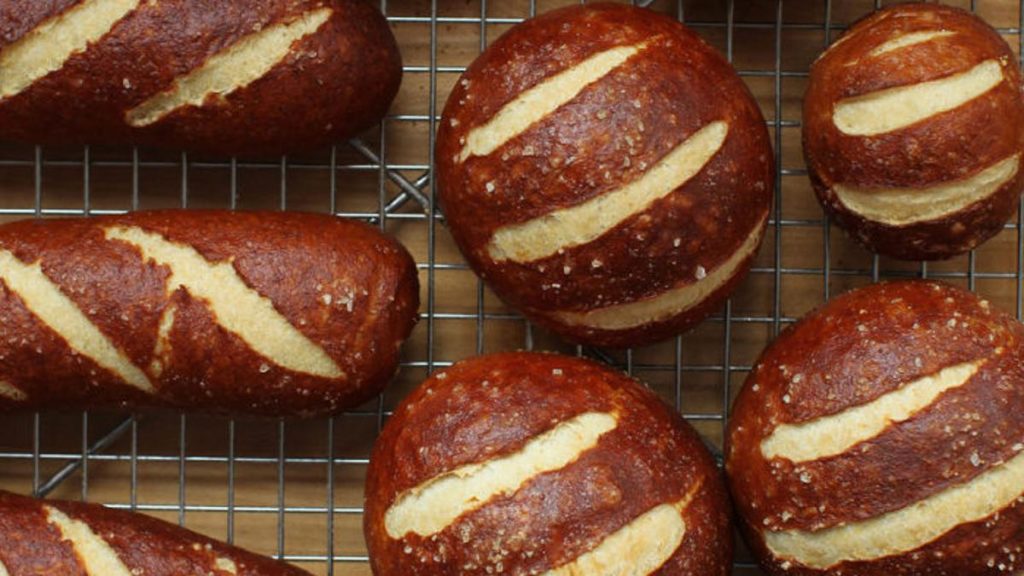
Pretzel – Soft pretzels, pretzel bread (which is simply soft pretzel dough shaped into little loaves) and bagels are like each other, and different from most other breads, because they are boiled before baking. On contact with the hot water, the starches on the surface of the dough gelatinize, forming a protective crust.
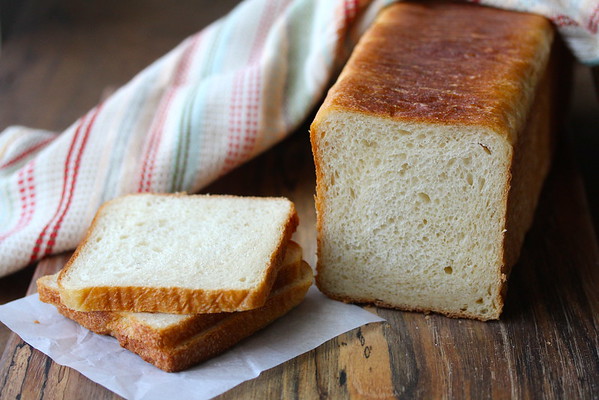
Pain de Mie – A pan loaf is a style of bread loaf baked in a pan or tin. It is the most common style available in the United Kingdom, though the term itself is mainly Scottish and Northern Irish to differentiate it from the plain loaf. It was once more expensive than the then more common plain loaf.
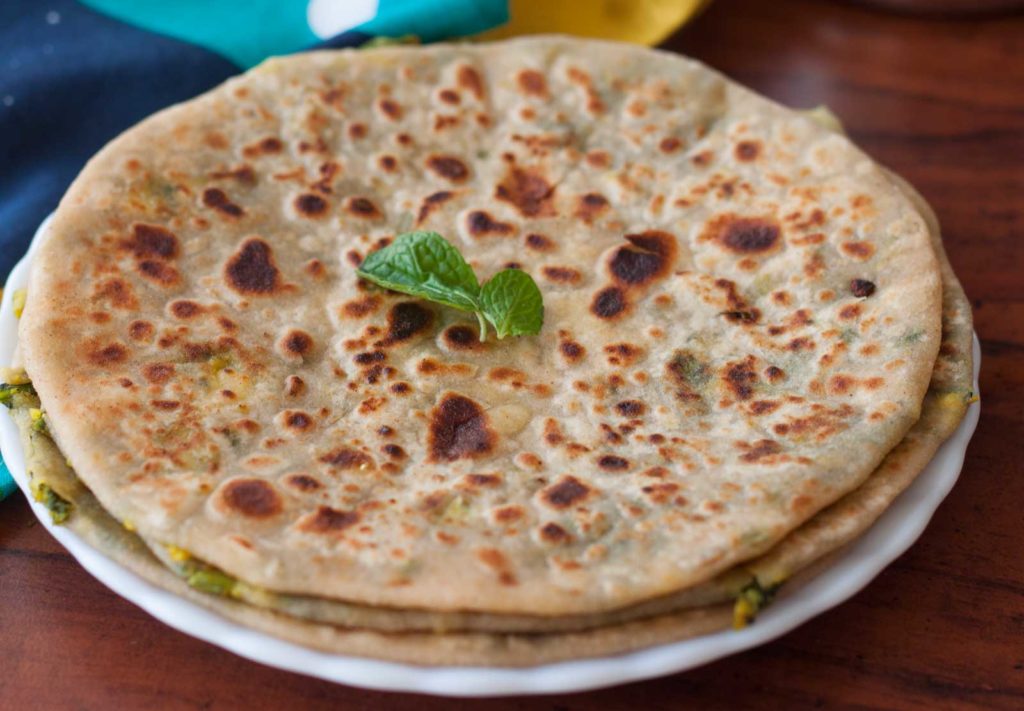
Paneer – Paneer is a fresh cheese common in the Indian subcontinent. It is an unaged, non-melting soft cheese made by curdling milk with a fruit- or vegetable-derived acid, such as lemon juice.
Q:
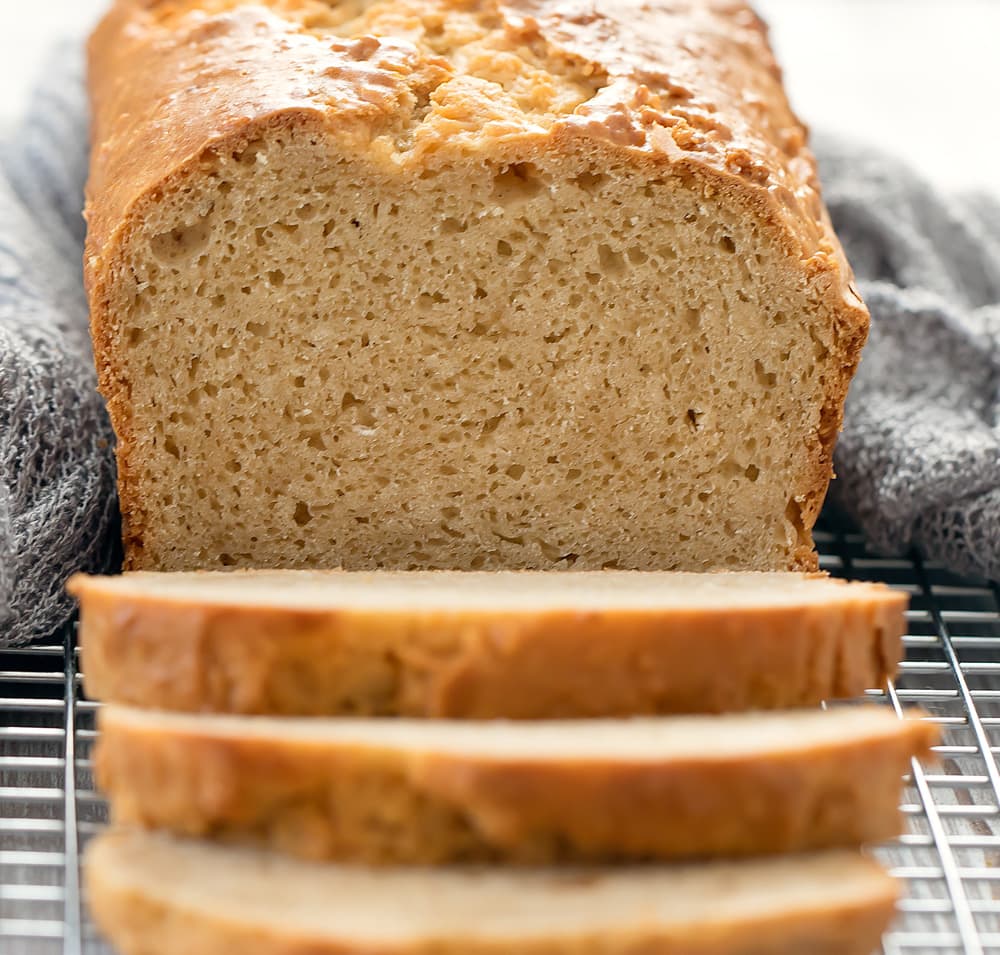
Quick bread – Quick bread is any bread leavened with a chemical leavening agent rather than a biological one like yeast or sourdough starter.
R:
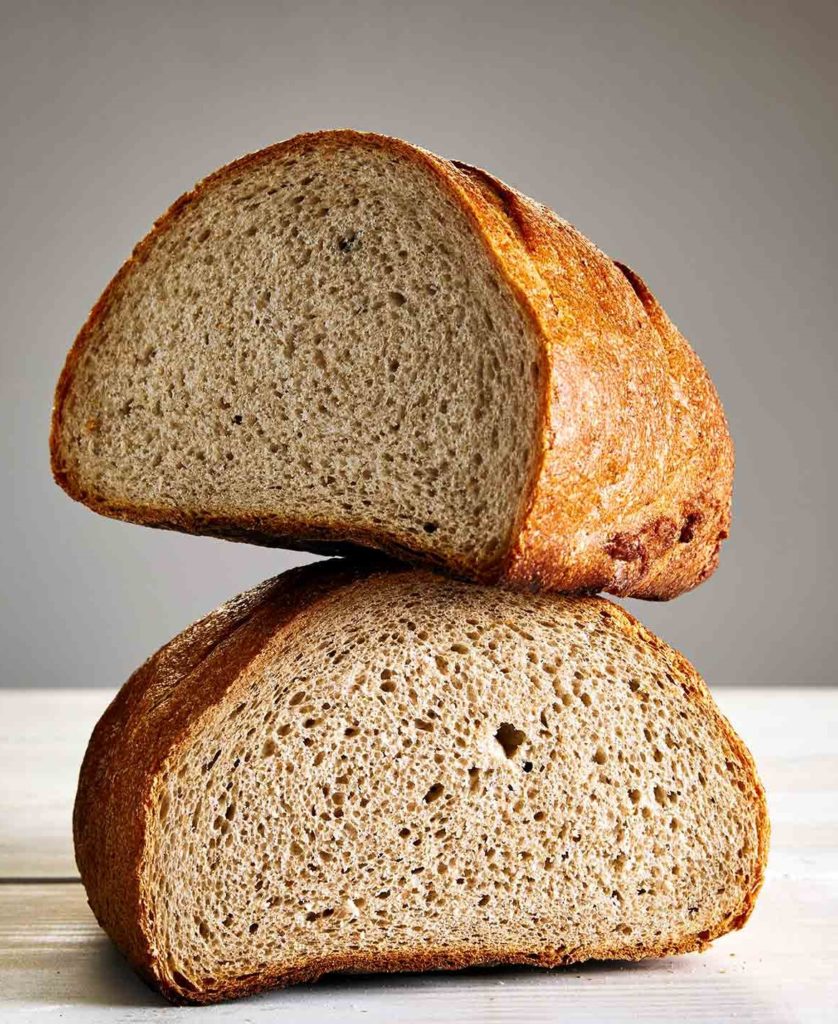
Rye – Made with both rye flour and bread flour, rye bread consists of a tight crumb and an extraordinarily strong flavor. Some bakers add caraway seeds or dill seeds so that their flavor is a little earthy. In certain sandwiches – most notably, corned-beef and pastrami sandwiches – the rye bread is what gives it the signature taste that most people love, and they become even more appreciated when you add a little mustard.
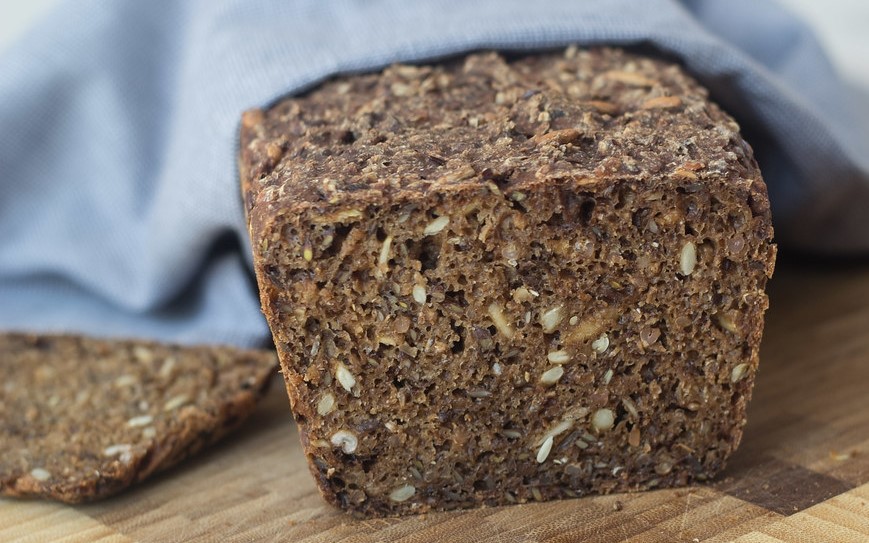
Rugbrød – is a quite common form of rye bread in Denmark. Rugbrød usually resembles a long brown extruded rectangle, no more than 12 cm high, and 30–35 cm wide, depending on the bread pan in which it is baked.
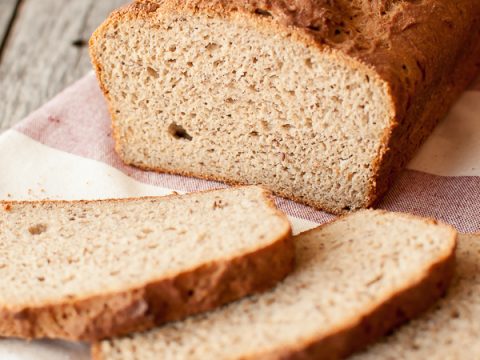
Rice bread – Rice bread is a type of bread that is made from rice flour rather than wheat flour. Being gluten free, it will not cause adverse reactions for people with gluten intolerance.
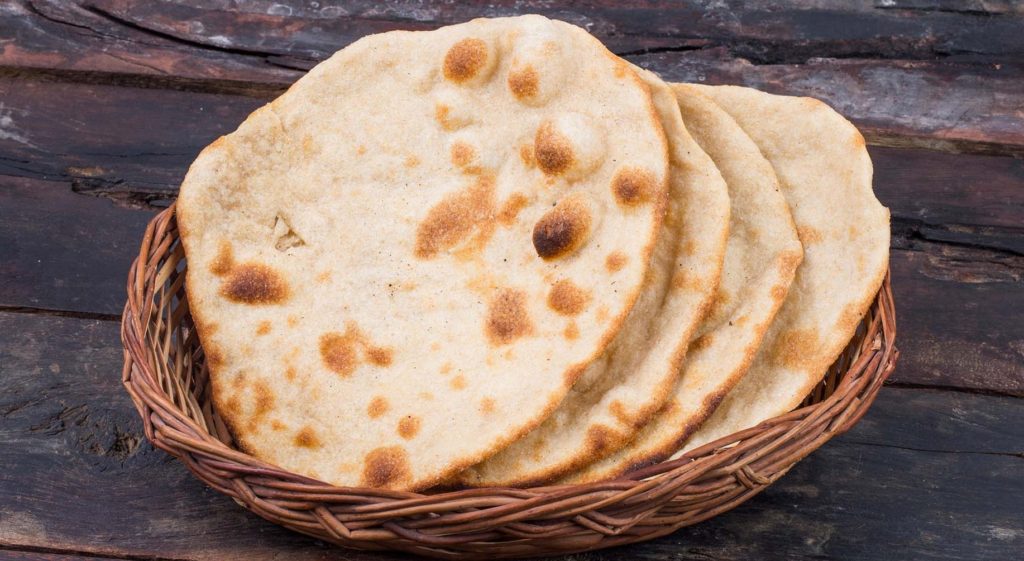
Roti – An unleavened flatbread, this bread is like Chapatti bread, and it is extremely popular in the Caribbean and in India. They are usually made with whole-wheat flour and water, and they are often coated with butter before baking to add a little flavor to them. In many cultures, Roti bread is served with spices as a healthier snack alternative.
S:

Sourdough – With sourdough bread, a starter is used in the beginning to create the recipe. The starter usually consists of a fermented combination of water and flour, which in turn makes many different batches of bread. Another advantage of this type of bread is that the starter lasts an exceedingly long time, which means you can enjoy making new loaves for quite long. Sourdough bread has a nice thick crust and a soft chewy center, along with exceptionally large air bubbles. It also has a very distinct taste that you will want more of once you try it.
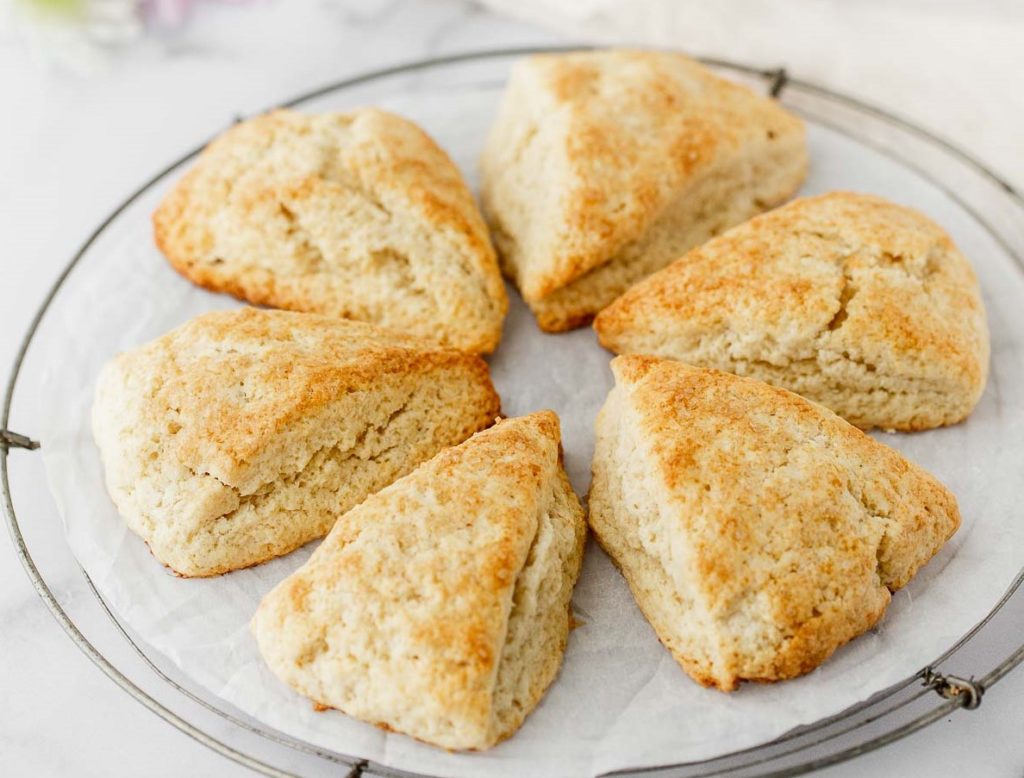
Scone – A scone is a baked good, usually made of wheat, or oatmeal with baking powder as a leavening agent and baked on sheet pans. A scone is often slightly sweetened and occasionally glazed with egg wash.
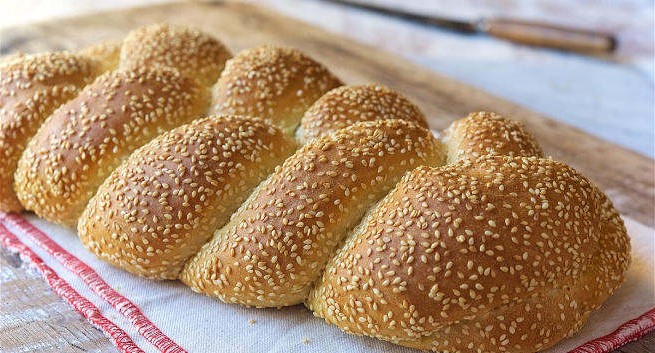
Scali Bread – is an Italian style of bread made predominantly in the Boston, Massachusetts area. It is a braided loaf that is covered in sesame seeds. It was originally made by the Scali family of Boston and is now a regional specialty.
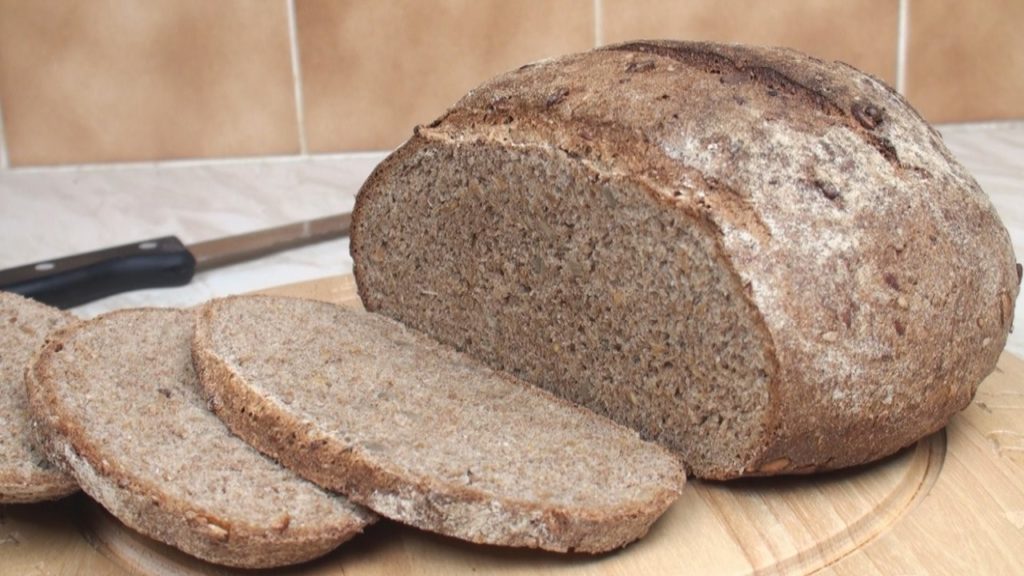
Spelt bread – is made from spelt flour instead of wheat flour. Depending on the recipe, spelt breads can contain 100% spelt flour or a blend of spelt and wheat flours. So, spelt bread is kind of like rye bread or oat grain bread in that it contains a grain flour that is something other than wheat.

Sprouted bread – is a type of bread made from whole grains that have been allowed to sprout, that is, to germinate, before being milled into flour. There are a few different types of sprouted grain bread. Some are made with additional added flour, some are made with added gluten, and some, such as Essene bread and Ezekiel bread (see up).
T:
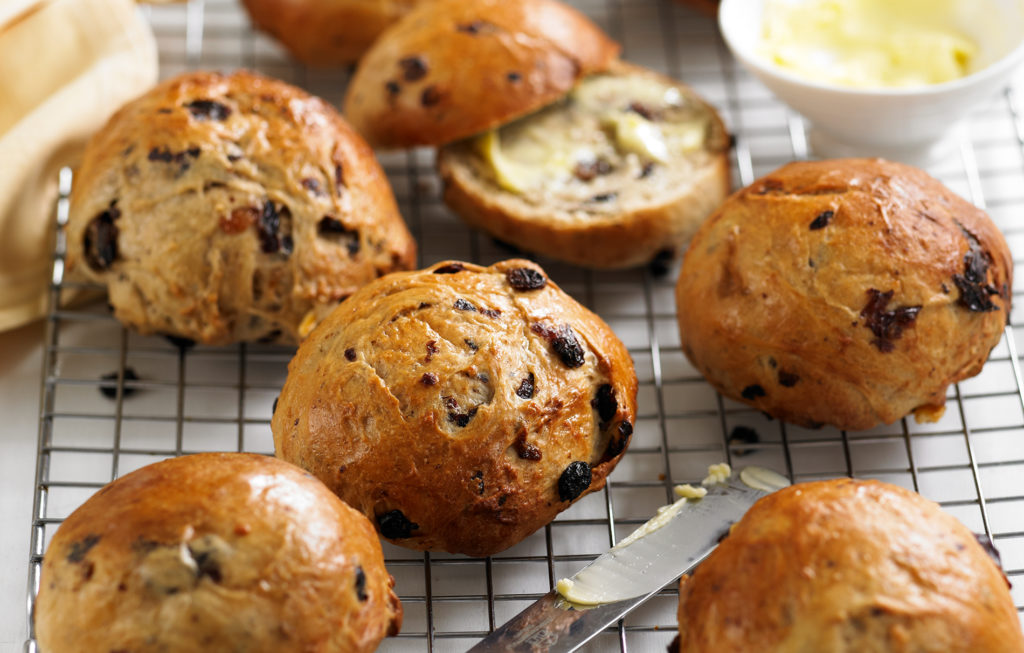
Teacake – England, a teacake is a light, sweet, yeast-based bun containing dried fruits, most usually currants, sultanas (raisins), or orange peel. It is typically split, toasted, buttered, and served with tea. It is flat and circular, with a smooth brown upper surface and a somewhat lighter underside.
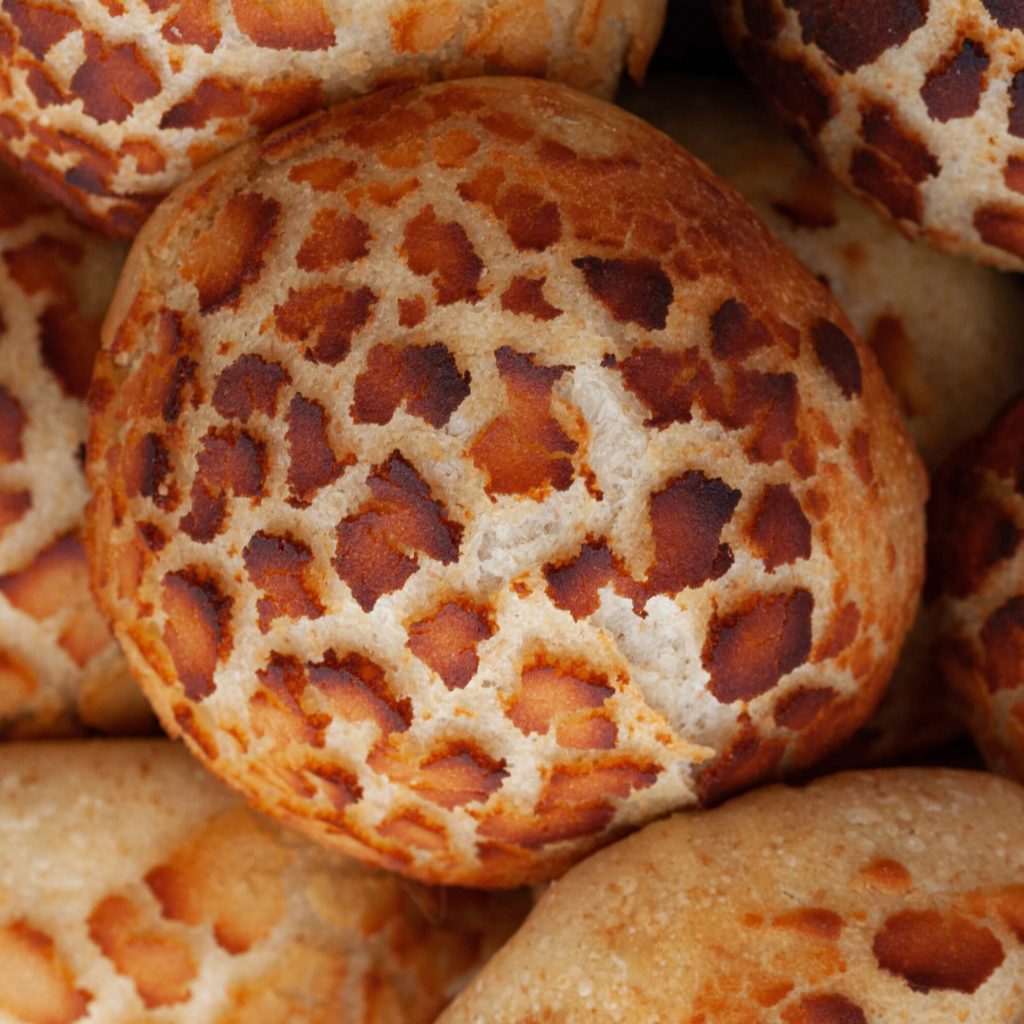
Tiger bread – The bread is generally made with a pattern baked into the top made by painting rice paste onto the outside before baking. The paste dries and cracks during the baking process. The rice paste crust also gives the bread a distinctive flavor. It has a crusty exterior but is soft inside. Typically, tiger bread is made as a white bread loaf of bread roll.
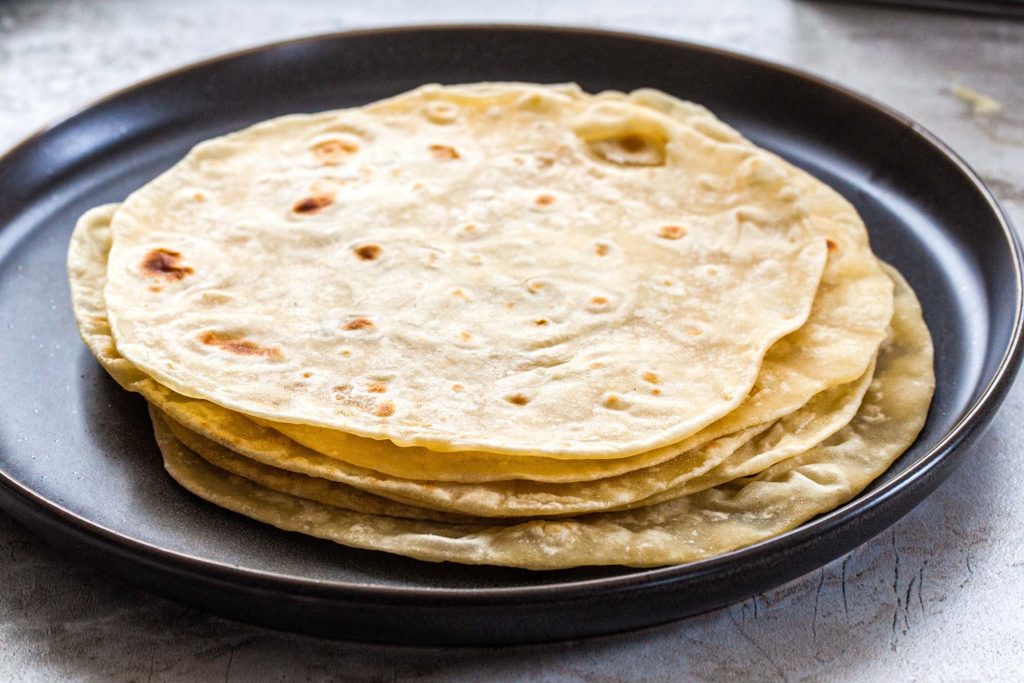
Tortilla (wrap) – Tortillas are soft, thin flatbreads utilized in numerous Mexican dishes, including enchiladas, burritos, wraps, and of course, tacos. Some are deep fried, and some are not, but the good news is that you can alter the recipe a bit to make it a tad healthier without going to too much trouble. You can also use them with foods that include chicken, pork, and beef, so they are a very versatile type of bread.
W:
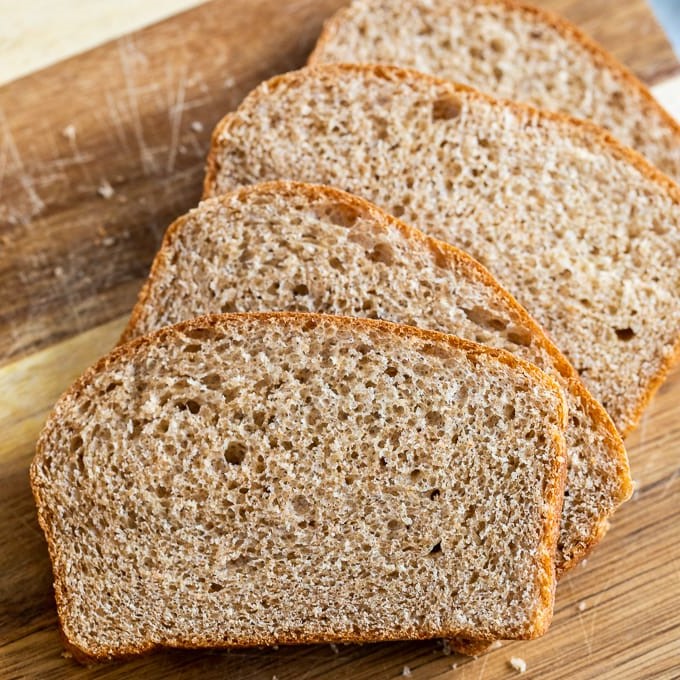
Whole wheat bread – With white bread, only parts of the wheat grain are used, but in whole-wheat bread the germ and the bran are intact. It sounds complicated, but it simply means that the bread is more nutritious and has much more fiber than regular bread. You can use whole-wheat bread for any type of sandwich you would normally use white bread for, and you can make up your own recipes if you are creative enough.
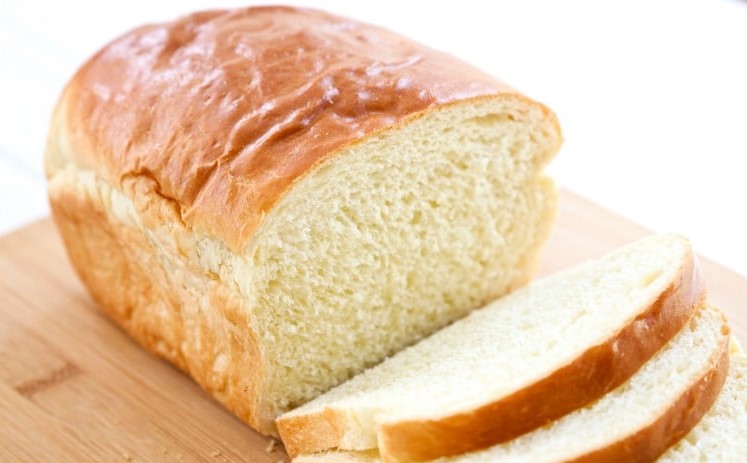
White bread – White bread typically refers to breads made from wheat flour from which the bran and the germ layers have been removed from the whole wheatberry as part of the flour grinding or milling process, producing a light-colored flour.
Y:
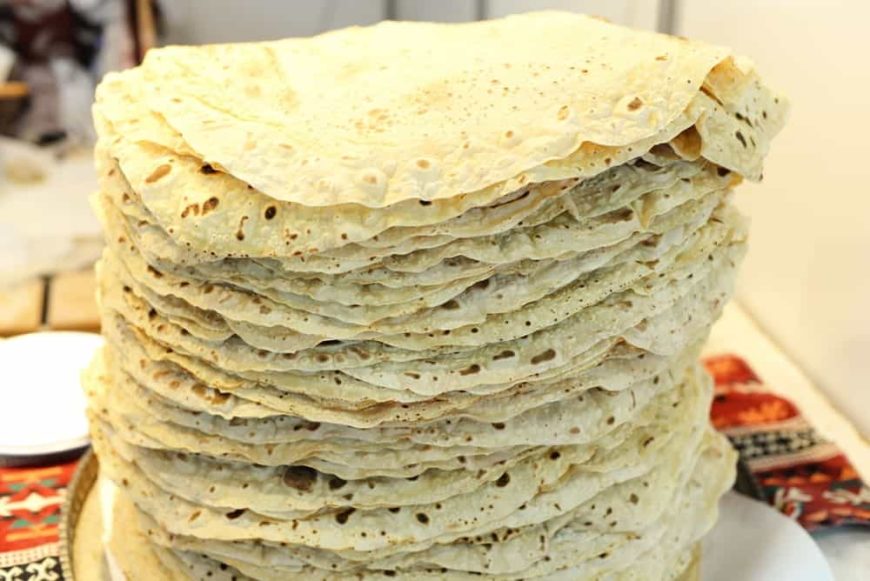
Yufka bread – This is a paper-thin unleavened bread that is round and comes from Turkey. It is like Lavash bread and is usually made from ingredients such as wheat flour, salt, and water. You can include this type of bread in pastries with either sweet foods such as nuts or dried fruits, or with foods such as meats, cheeses, and vegetables.
Z:
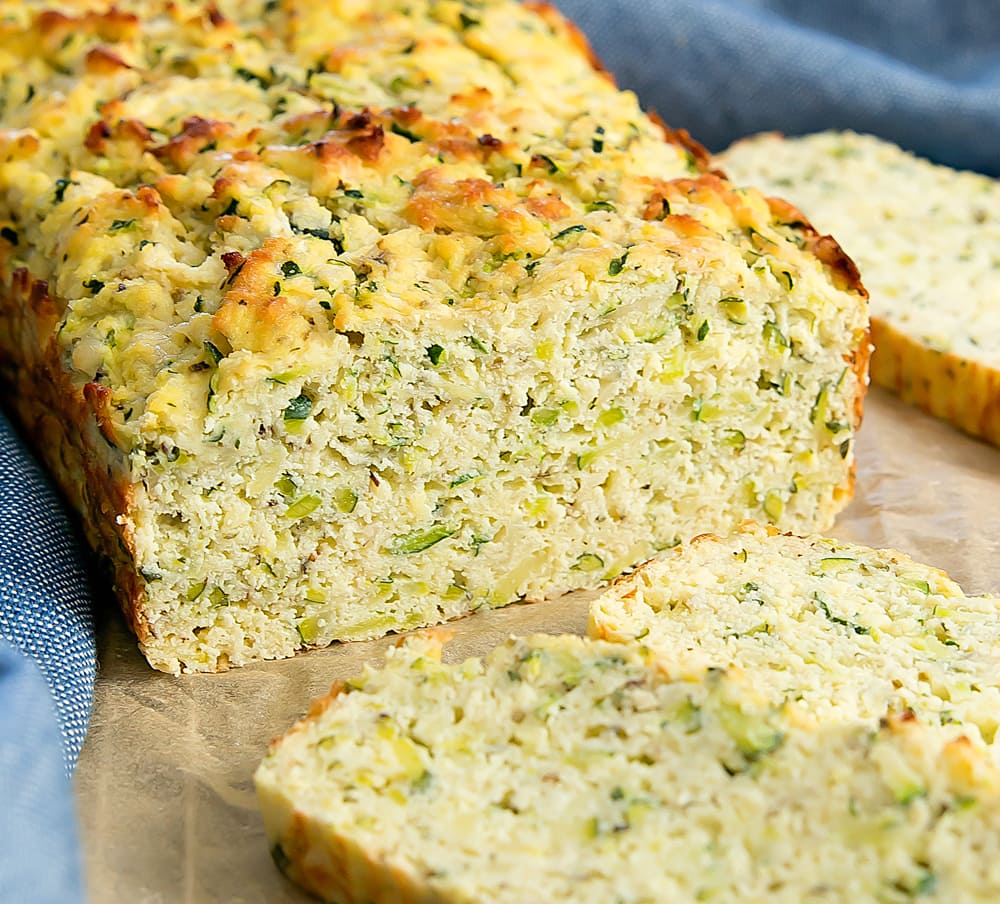
Zucchini bread – Zucchini bread tastes like the combination of spices you add to the batter. This zucchini bread, however, also tastes like vanilla and brown sugar. Brown sugar is one of my favorite ingredients to bake with– like zucchini, it adds wonderful moisture and a touch of sweet molasses flavor. Additionally, you will taste cozy cinnamon spice and a little pinch of nutmeg. I gave a loaf to one of my friends and she could not quite put her finger on the added flavor– she said she *loved* the spice flavor. It is the nutmeg! Adds a little something special.
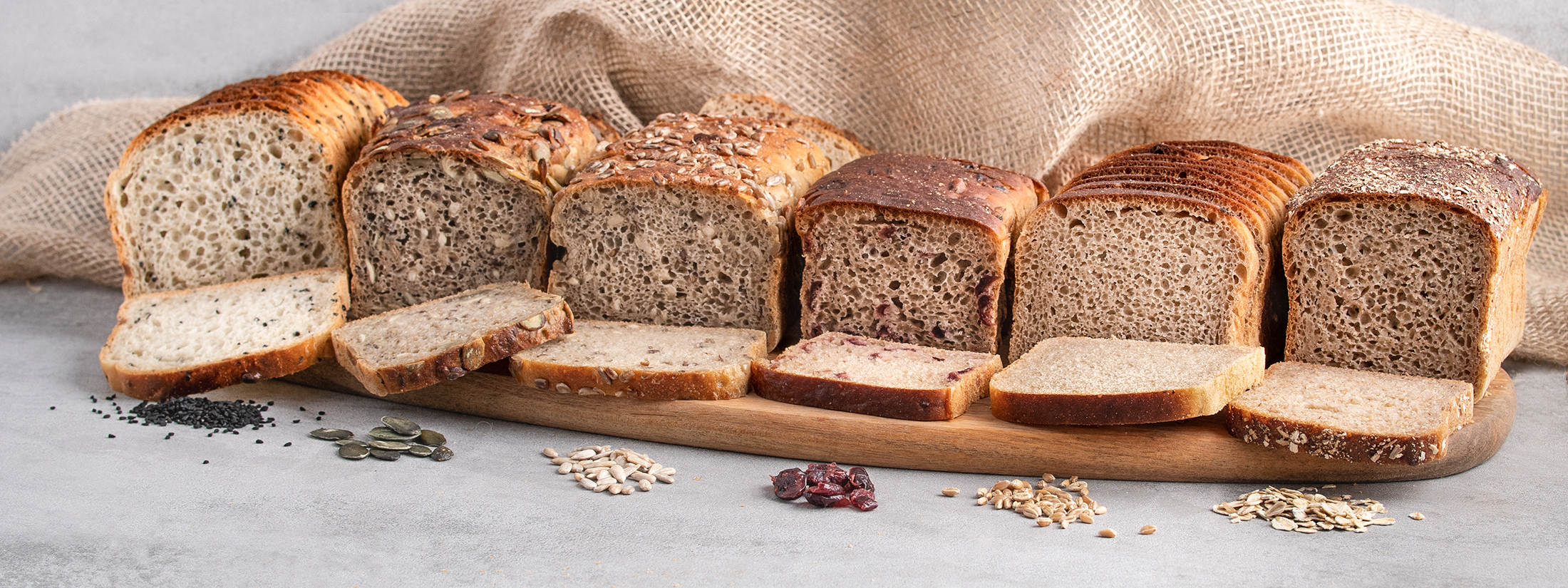


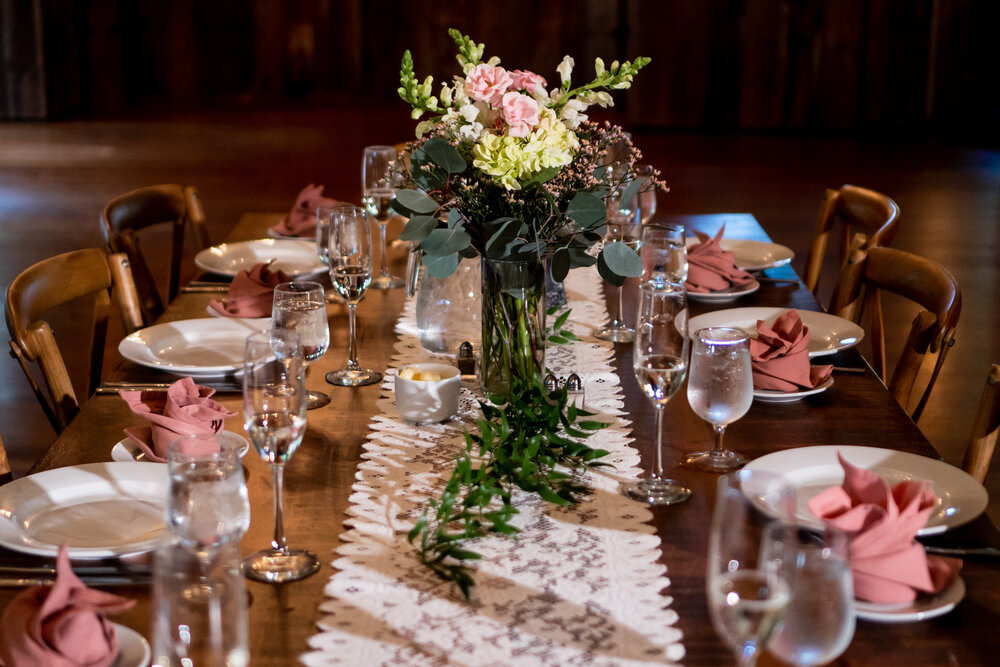
😍😍😍😍
Bread is awesome! I could eat all breads anytime especially when there is melted cheese involved. Great post!